Please help us preserve St. Michael’s rich Eastern European history by offering anniversary booklets/photographs, and/or various society booklets/photographs (i.e.: Rosary Society, Holy Name Society, Immaculate Conception Sodality, etc.).
If you are unable to email your contribution please feel free to forward it to us via US Post Office. We will promptly return your submission and reimburse your postage costs. If interested Email us for details.
During the latter part of the Nineteenth century, a large influx of immigrants arrived in the City of Passaic. Along with shops, stores and other service-orientated businesses, immigrants turned to building various houses or worship for their spiritual needs. An imposing edifice constructed was Saint Michael’s United Greek Catholic Church. It was in the Dundee section of Passaic this church would grow and expand. In 1890 Reverend Nicephor Chanath formerly undertook the limited work of Father Alexander Dzubay. Father Chanath was a scholar/priest who hailed from the Diocese of Munkacs which was located in the Austro-Hungarian Empire. Being a man of great educational background and foresight, Father Chanath realized a church was necessary for the immigrant population who were of the Greek Catholic religion. He was sent to the City of Passaic to organize a new church and he functioned though the Apostolic Delegate Satolio of Washington, D.C. On November 14, 1891 he met with a number of families to begin a future parish. During this meeting individuals were selected to make this dream a reality. Father Chanath appointed Michael Boyko, Peter Kovalycsik, Joseph Nebesnyak, and Michael Prisztas to explore ideas for building a church. Father Chanath and the original founders petitioned Bishop Wigger of the Diocese of Newark for the necessary permission to proceed. A suitable site was located and The Dundee Evangelical Mission Church was purchased. After necessary renovations were completed, the church was dedicated to the Archangel Michael with the official name of Saint Michael’s United Greek-Catholic church. This church became the second Catholic Church in the City of Passaic. By November 14, 1892, Stephen Sokol and Nicholas Hytra were elected the first trustees of Saint Michael’s.
Photo Courtesy of Joy E. Kovalycsik
Saint Michael’s originally had a seating capacity of 300 individuals. Father Chanath worked tirelessly to expand the church and when his tenure ended on December 20, 1894, Saint Michael’s was firmly established. Bishop Wigger of Newark then appointed Father Eugene Szatala to oversee the new church. During Father Szatalas tenure the parish grew in large part via the constant immigration from Eastern Europe and, this was the only church for Greek Catholics in Passaic. During March, 1902, another priest, Father Nicholas Molcsanyi was sent to Saint Michael’s. During this period, families from Passaic, Garfield, Clifton, Lodi and some from as far as Dover, New Jersey were members. New families increased the number of parishioners and by the later parts of 1902; church membership consisted of 600 families. Due to this expansion, the original church became too confined for religious worship. Plans were drawn to expand the church upon its original site. This expanded church offered two magnificent towers, complete with a clock set within each tower that chimed upon the hour. These towers (soaring upwards 140 feet into the air) were not without problems and during a storm in 1903, one totally collapsed. Both towers had to be taken down and re-constructed by the order of the Building Department of the City of Passaic. A main Cupola rested on top of the main roof and this church could be seen for miles. Both towers and the cupola were graced by an Eastern three-bar Cross. After many set-backs, expansions and renovations, the interior of the church was finished and held approximately 800 individuals. During the early months of 1902, a few internal religious divisions began. Unfortunately, there were disputes over spiritual and material issues. Father Nicholas Molcsanyi strove with great patience to heal the tensions. However, no resolution could be reached and some members withdrew The members who left Saint Michael’s requested Father Volosin, a priest from Hungary, serve as pastor and erected a Greek Catholic Church two blocks away from Saint Michael’s. After leaving, the turmoil escalated in this new church and they left the faith of their ancestors for the Orthodox Church.
During January of 1906, Father Iren Janicky was appointed the pastor by Bishop John J. O’Connor of Newark. Peter Kovalycsik was appointed Treasurer of Saint Michael’s by the Vicar General of the Diocese, Monsignor Sheppard of Jersey City. Under Father Janicky various societies began such as Saint Michael’s Rosary Society. Father Janicky stayed with Saint Michael’s until September, 1915 when Father Valentine Balogh, was appointed by the first Greek Catholic Bishop in the United States, the Right Reverend Sotor Ortynsky of Philadelphia, Pennsylvania. Father Balogh administered the parish during these high years of expansion and left Saint Michael’s in 1918. During 1918, the Very Reverend Martyak, Apostolic Administrator of the Greek Catholic church in the United States appointed Father Michael Jackovics to administer Saint Michael’s. Father Michael Jackovics had previously served at Saint John the Baptist Greek Catholic church in Scranton, Pennsylvania for sixteen years. When Father Jackovics arrived in Passaic, Saint Michael’s membership had swelled to over 3,000 members. Father Jackovics was a hard working priest and competent administrator. Under his tenure two rooms were converted for school instruction use and various renovations and expansions were conducted under his guidance. Father Jackovics had a long and very constructive tenure at Saint Michael’s and he would become the first long-term pastor.
Father Michael Jackovics was born in the village of Puznyak-Falva in the Austro-Hungarian Empire on January 24, 1875. He came from a very long and distinguished line of Greek Catholic clergy in his homeland. His father had been a Greek Catholic priest and for seven generations his family had been Greek Catholic clergy. Father Jackovics was educated in the high school which was located in Ungvar (Užhorod) and upon completion entered University in the same city. He was ordained a Greek Catholic priest when he was twenty-three years old by the Right Reverend Julius Firczak, Bishop of the Munkacs diocese. He was an assistant priest in Hust which was one of the larger congregations within the entire diocese. Father Jackovics arrived in the United States and originally settled in Bridgeport, Connecticut. After Bridgeport, he was assigned to Lansford, Pennsylvania and in 1902, was offered an invitation by the Right Reverend M. J. Hoban, Bishop of Scranton, Pennsylvania to take charge of Saint John the Baptist Greek Catholic church. During 1908, Father Jackovics was elected spiritual director of the Greek Catholic Union of the United States which had over 100,000 members. Father Jackovics as was the custom in the Greek Catholic church had married before ordination. He was married in Makaria, Austro-Hungary to Yolanda Kaminsky. Yolanda Kaminsky was also from a priestly family. Her father was stationed in the United States as rector at a Greek Catholic church. As of 1922, Father Jackovics and his wife, Pani Yolanda had five children, Thomas, Joseph, Michael, Yolanda and Theodore. Under Father Jackovics many improvements and expansions would be seen. He opened the first official part of a new cemetery for Saint Michael’s in 1921 and consecrated the remaining ground in 1936. He was also instrumental in the construction of a modern rectory and church auditorium which are still utilized by the church today.
After serving Saint Michaels for over 31 years Father Emil Masich was installed as temporary pastor upon the death of Father Jackovics. In 1950, Father John Stim (later to be elevated to Monsignor in 1959) was installed as pastor. Monsignor Stim oversaw the Immaculate Conception Sodality, a Junior Choir and Boy Scout Troop. He was always focused on spiritual and social matters. Addressing the needs of the younger members of the parish was very important during his pastorate. Later, renovation projects were implemented some of which were updating the interior, placing new pews in the church, obtaining modern light fixtures and installing a brand new heating system. Monsignor Stim also saw the creation of Saint Michael’s Parochial School. He invited teaching sisters from the order of the Sister Servants of Mary Immaculate (their Motherhouse was in Toronto, Canada) to teach at the school. People still recall how the Sisters decorated all the ground floor windows yearly. At the beginning of the school year, autumn scenes were painted, in March spring scenes and finally summer scenes were painted in May and June. These artistic sisters were school principal, Sister Cyprian along with Sister Rosalie, Sister Ivanna and Sister Aurella.
The highest honor Saint Michael’s received was bestowed on this dynamic and faithful church during July of 1963. The Apostolic Delegate to the United States informed Saint Michaels that His Holiness Pope Paul VI established a new diocese for Byzantine (i.e. Greek) Catholics. The new Diocese would be named the Diocese of Passaic and Saint Michaels would be the Cathedral church. The first Bishop of Passaic, Stephen J. Kocisko was installed in September of 1963. Due to this designation, a review of the church exterior and interior was taken. It was decided the original church towers and domes should be removed. New more practical towers were put into place. After 13 years of dedicated service, Monsignor Stim was transferred and a new pastor, Monsignor George Durisin, Vicar General for the new Diocese was installed as pastor of Saint Michael’s Cathedral.
Monsignor Durisin was a devoted priest and oversaw a number of events in the life of Saint Michaels. The exterior of the church under his leadership was brick faced, new carpeting was installed and more upgrades and renovations were performed. A tireless worker, Monsignor Durisin also thought of the future and was very concerned for the spiritual welfare of his members. He established an expansive CCD program so the young people of the parish had weekly instruction in the faith. Also, knowing how important the church cemetery was to Saint Michael’s, he reviewed the cemetery and made wise improvements and additions which were greatly appreciated.
In 1969 a second Bishop for the Diocese of Passaic, Bishop Michael Dudick was consecrated and installed at the Cathedral. Monsignor Durisin also witnessed the 90th Anniversary of the church and many other renovations were managed under his pastorate. The Cathedral joyfully celebrated its 90th Anniversary on November 9, 1980. How far Saint Michaels had come from the initial church which only had a seating capacity of 300 people! It was the steadfast faith in God of the past and current members in conjunction with their clergy and the deep love held for their Greek Catholic (Byzantine Rite) faith which brought them to this celebration.
Saint Michael’s continued its growth and expanded. In 1982 a new Diocesan Center and Chapel were built in Woodland Park, New Jersey. Many members now resided in areas a far distance from the Cathedral. The building of a chapel was very beneficial for those members who could now worship closer to their areas of residence. The Chapel has a seating capacity of 250 and includes a social hall and classrooms on the lower level. The Diocesan Center building across from the chapel also hosts the Eparchial Heritage Museum and Library. A repository of history, numerous items are tenderly cared for at the museum for present and future generations. Some holdings are priceless such as liturgical items, chalices, liturgical books, jewelry, original paintings, music, prayer books and cultural items. The preservation of the history of the Diocese is a testament to all who worked so hard to preserve these items. The Chapel of Saint Michael the Archangel was solemnly blessed in May of 1987 and regular services, which now include two Liturgies weekly, are held.
Monsignor Durisin left to undertake duties as Director of Formation and Vice-Rector at the Byzantine Catholic Seminary in Pittsburg in 1988. Two successive priests served the faithful of Saint Michaels during this time, Father Eugene Fulton and Monsignor Nicholas Alishofski. Unfortunately, both pastors’ experienced unexpected illness and they had to depart Saint Michael’s Cathedral. For the first time in many years, Saint Michael’s was without a long term pastor.
The members of Saint Michael’s were terribly shaken at the loss of two pastors within a very short period. However, God provided a new pastor to comfort and guide the parish. In 1989, Father Marcel Szabo was installed as the new pastor of Saint Michael’s. Father Marcel’s kind personality, sincerity and humble spirituality instantly revitalized the parish. A tireless worker and, with the Centennial Anniversary not far in the future, Father Marcel set out to prepare for the celebration. In August of 1989, Saint Michael’s Cathedral and the entire City of Passaic were dedicated to the loving arms of the Blessed Mother. Bishop Dudick presented the Cathedral 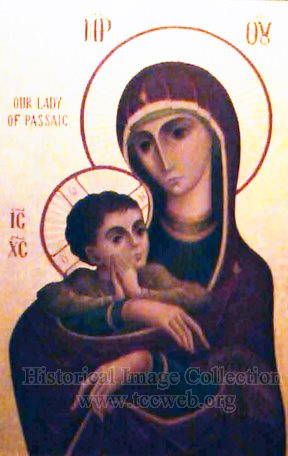 with an icon “Our Lady of Passaic.” (Photo Courtesy of Joy E. Kovalycsik) This beautiful icon can be viewed today in the church. The icon is flanked on each side by an icon of the Archangel Rafael on the left and an icon of the Archangel Michael on the right. The icon portrays the Blessed Mother holding the infant Jesus in her arms. All who light candles and pray are tenderly looked upon by this beautiful icon.
with an icon “Our Lady of Passaic.” (Photo Courtesy of Joy E. Kovalycsik) This beautiful icon can be viewed today in the church. The icon is flanked on each side by an icon of the Archangel Rafael on the left and an icon of the Archangel Michael on the right. The icon portrays the Blessed Mother holding the infant Jesus in her arms. All who light candles and pray are tenderly looked upon by this beautiful icon.
During the years leading up to 1990 many improvements were made. A renovation of the current rectory was undertaken. The CCD program, now renamed the Eastern Christian Formation Program (ECF) was relocated to the classrooms at the Chapel facility. As always, the dedication of the members to the Cathedral was overwhelming. The Ladies Guild donated $25,000 for replacement of the rectory windows and numerous parishioners offered their time and talents to assist in any way they could during the renovations.
Finally, on the Feast of Saint Michael the Archangel, November 8, 1989, the parish formally began their Centennial Celebrations. Numerous programs were held, some being a Homecoming Dinner Dance, a Slavic Music Festival and a Centennial Picnic which saw an attendance of approximately 1,000 people.
On Sunday, November 7, 2010, Saint Michaels Cathedral once again had cause to rejoice. At this time the 120th Anniversary Celebration was scheduled. A solemn Hierarchal Divine Liturgy at which the Cathedral choir magnificently sang the responses was held. The main celebrant was the current Bishop of Passaic, the Most Reverend William C. Skurla, D.D. After the service all attended the anniversary banquet at The Venetian in Garfield, New Jersey. The banquet hall was filled with clergy, religious, parishioners and friends of the Cathedral. The affection and devotion people have for Saint Michael’s has always been constant. An overwhelming success; the Hierarchal Divine Liturgy and banquet offered everyone a chance to participate in celebrating 120 years of God’s blessings and grace upon Saint Michael’s Cathedral.
During the latter part of the Nineteenth century, a large influx of immigrants arrived in the City of Passaic. Along with shops, stores and other service-orientated businesses, immigrants turned to building various houses or worship for their spiritual needs. An imposing edifice constructed was Saint Michael’s United Greek Catholic Church (which, in later years would be raised to the status of a Cathedral). It was in the Dundee section of Passaic that this church would grow and expand. In 1890 Reverend Nicephor Chanath formerly undertook the limited work of Father Alexander Dzubay. Father Chanath was a scholar/priest who hailed from the Diocese of Munkacs which was located in the Austro-Hungarian Empire. Being a man of great educational background and foresight, Father Chanath realized a church was necessary for the immigrant population who were of the Greek Catholic religion. He was sent to the City of Passaic to organize a new church and he functioned though the Apostolic Delegate Satolio of Washington, D.C. On November 14, 1891 he met with a number of families and began Saint Michael’s United Greek-Catholic church. During this meeting a group of individuals were selected to make this dream a reality. Father Chanath appointed Michael Boyko, Joseph Nebesnyak, Peter Kovalycsik and Michael Prisztas to explore ideas to build a church. Once a suitable site was located, this group along with Father Chanath petitioned Bishop Wigger of the Diocese of Newark for the necessary permission to proceed. By November 14, 1892, Stephen Sokol and Nicholas Hytra were elected the first trustees of Saint Michael’s. The church had purchased the Dundee Mission church on First Street and began the necessary renovations to convert the former Protestant mission church into a Greek Catholic house of worship.
Saint Michael’s originally had a seating capacity of 300 individuals. Father Chanath worked tirelessly to expand the church and when his tenure ended on December 20, 1894, Saint Michael’s was firmly established. Bishop Wigger of Newark then appointed Father Eugene Szatala to oversee the new church. During Father Szatala’s tenure the church grew in large part via the constant immigration from Eastern Europe and, this was the only church for Greek Catholics in Passaic. During March, 1902, another priest, Father Nicholas Molcsanyi was sent to Saint Michael’s. During this period, families from Passaic, Garfield, Clifton, Lodi and some from as far as Dover, New Jersey were members. New families increased the congregation and by the later parts of 1902, church membership consisted of 600 families. Due to this expansion, the original church became too confined for religious worship. Plans were drawn to expand the church upon its original site. This expanded church offered two magnificent towers, complete with a clock set within each tower. These towers were not without problems and during a storm in 1903, one totally collapsed. Both towers had to be taken down and re-constructed by the order of the Building Department of the City of Passaic. A main "Cupola" rested on top of the main roof and this church could be seen for miles. Both towers and the cupola were graced by an Eastern three-bar Cross. After many set-backs, expansions and renovations, the completion date of 1905 saw the interior of the church holding approximately 800 individuals. Prior to 1905 many internal religious divisions began which had a negative effect upon the membership. The church became split upon various spiritual and material issues. The priests of Saint Michael’s were caught up in these divisions along with their members. Seeing no resolution to the conflicts, many members prior to 1905 had withdrawn and erected Saints Peter and Paul Greek Catholic church located two blocks away from Saint Michael’s on Third Street. During and after 1905 other members of Saint Michael’s would leave for Saints Peter and Paul’s and, later on, build another church which would leave the Greek Catholic church and return to the Russian Orthodox jurisdiction.
During February of 1906, Father Iren Janicky was appointed the administrator by Bishop John J. O’Connor of Newark. Father Janicky stayed with Saint Michael’s until September, 1915 when Father Valentine Balogh, was appointed by the first Greek Catholic Bishop in the United States, the Right Reverend Sotor Ortynsky of Philadelphia, Pennsylvania. Father Balogh administered the parish during these high years of expansion and left Saint Michael’s in 1918. During 1918, the Very Reverend Martyak, Apostolic Administrator of the Greek Catholic church in the United States appointed Father Michael Jackovics to administer Saint Michael’s. Father Michael Jackovics had previously served at Saint John the Baptist Greek Catholic church in Scranton, Pennsylvania for sixteen years. When Father Jackovics arrived in Passaic, Saint Michael’s membership had swelled to over 3,000. Father Jackovics was a very hard working priest and competent administrator. Under his tenure two rooms were converted for school instruction use and various renovations and expansions were conducted under his guidance. Father Jackovics would have a long and very constructive tenure at Saint Michael’s and he would become the first long-term priest since the churches inception.
Father Michael Jackovics was born in the village of Puznyak-Falva in the Austro-Hungarian Empire on January 24, 1875. He came from a very long and distinguished line of Greek Catholic clergy in his homeland. His father had been a Greek Catholic priest and for seven generations his family had been Greek Catholic clergy. Father Jackovics was educated in the high school which was located in Ungvar and upon completion entered University in the same city. He was ordained a Greek Catholic priest when he was twenty-three years old by the Right Reverend Julius Firczak, Bishop of the Munkacs diocese. He was an assistant priest in Hust which was one of the larger congregations within the entire diocese. Father Jackovics arrived in the United States and originally settled in Bridgeport, Connecticut. After Bridgeport, he was assigned to Lansford, Pennsylvania and in 1902, was offered an invitation by the Right Reverend M. J. Hoban, Bishop of Scranton, Pennsylvania to take charge of Saint John the Baptist Greek Catholic church. During 1908, Father Jackovics was elected spiritual director of the Greek Catholic Union of the United States which had over 100,000 members. Father Jackovics as was the long standing custom in the Greek Catholic church had married before ordination. He was married in Makaria, Austro-Hungary to Yolanda Kaminsky. Yolanda Kaminsky was also from a priestly family. Her father was stationed in the United States as rector at a Greek Catholic church. As of 1922, Father Jackovics and his wife, Pani Yolanda had Thomas who was a student of medicine at Georgetown University in Washington, D.C., Joseph, a student at New York University, Michael, a student at Seton Hall University, South Orange, New Jersey, Yolanda, a student at Marwood College, Scranton, Pennsylvania and Theodore, a student at St. Nicholas Parochial School, Passaic, New Jersey. Under Father Jackovics many improvements and expansions would be seen. He opened the first official part of a cemetery for Saint Michael’s in 1921 and consecrated the remaining ground in 1936. He was also instrumental in the construction of a modern rectory and church Auditorium which are still utilized by the church today.
On November 14, 1890 Saint Michael's was incorporated under the laws of the State of New Jersey with Joseph Nebesnyak and Michael Bojko as its first lay trustees. Saint Michael's became the second Catholic Church established in the City of Passaic.
The first baptism of Mary Hrinya was performed on December 25, 1890. Mary's parents were from the village of Ujak, Slovakia.
The first wedding of John Ferinko and Suzanna Chromoho was performed on January 1, 1891.
The first funeral of Michael Mascary was performed on June 16, 1891.
The corner stone of the newly constructed church was placed on Sunday, July 6, 1902 with twenty thousand people in attendance. Inset into the corner stone were the names of those who officiated at the ceremonies and those who had contributed towards the building fund be they member or non member. The church cost approximately $60,000.00 to construct.
On August 15, 1903, a raffle was held at Peter Kovalycsik’s hall on Second (Market) Street Passaic to dispose of the first church structure due to the construction of a new and expanded Saint Michaels. The winner of the raffle would have the right to remove or tear down the building. Tickets were one dollar each. Over one thousand tickets were sold. The funds raised were used to pay down the expenses for the building.
In 1905 the exterior of the new church was completed.
In 1906 the firm of Priore and Grecco, decorators, painted mural decorations and the entire interior of the church. The cost of labor and materials was $4,000.00.
In 1935 a new church hall and rectory was constructed.
On November 24, 1940 Saint Michael's celebrated its Golden Jubilee.
Saint Michael’s purchased City of Passaic School Number 2 and began St. Michael’s Parochial School in September, 1953. Teachers were nuns from the Sister Servants of Mary Immaculate order.
In 1965 Saint Michael's celebrated its Diamond Jubilee.
The Confraternity of Christian Doctrine (CCD), religious instruction program, was established in 1966.
Construction began in 1985 for a chapel and social center in West Paterson.
Saint Michael's Chapel in West Paterson was solemnly dedicated on May 31, 1987.
On November 12, 1989 "Saint Michael's Day" began the year-long Centennial Celebration.
In 1990 Saint Michael's observed its Centennial Jubilee.
In 2015 Saint Michael's celebrated its Quasquicentennial Jubilee.
Saint Michael’s has five Church bells cast by the McShane Bell Foundry of Baltimore, Maryland. The largest bell in the right tower was named “Andrew”, and weighs 4,300 pounds, it cost 1,300 dollars. In the left tower are found “Nicholas” which weighs 2,000 pounds, “Michael” which weighs 1,200 pounds, “Nicephor” which weighs 600 pounds and “Daniel weights approximately 300 pounds.
The architect’s plans for the new church were drawn by Louis Giele of Jersey City who also drew the plans for remodeling Passaic City Hall.
On Wednesday, January 28, 1891, Saint Michael’s “Hungarian and Slavonian Society” sponsored a formal dance at Rettinger’s Hall. Officers of the Society were Joseph Pristas, President, Michael Bolekas, Vice-President, George L. Molson, Secretary, John Kovalycsik, Assistant Secretary and Michael Bojko, Treasurer.
Upon entering the Cathedral in an area reserved for lighting candles, there are four wall length stained glass windows. The windows were donated by Andrew and Mary Chaky & Family (the Expulsion from the Garden of Eden), In Memory of Sgt. Peter Plavchan, Killed in Action in the Second World War (the Baptism of Jesus Christ), Michael and Anna Fecho (The Presentation) and Peter and Mary Choma (Penance).
Passaic Daily Herald Articles
With Permission of "The Herald"
Passaic Daily Herald - Monday - July 7, 1902
Thousands at St. Michael's Great Audience Witnesses Layinf of Altar Stone for New Church Vicar General and Former Rector of St. Nicholas Church Represents Bishop O'Connor at Ceremony of Greek Rite Congregation Held Yesterday Afternoon Others in Attendance
In the presence of at least twenty thousand people the first stone of the new church of St. Michael the Archangel was laid with appropriate ceremonies yesterday afternoon. The crowds which gathered to witness the ceremonies completely filled the space extending from the fence surrounding No. 2 school to the easterly bank of the canal a distance of at least six hundred feet. The ceremonies were preceded by a parade though the principal streets of the city. In the parade were several societies connected with St. Michael’s, St. Joseph’s Polish, and St. Marie’s Slavish (Slovak) church, together with a number of visiting societies. In the procession were two societies of the Children of Mary and Young Ladies’ Sodality connected with St. Marie’s and St. Joseph’s churches. They were all dressed in white and wore white veils. They attracted considerable attention as they marched through the streets. The brass band and the Slavish fife and drum corps headed the first and second divisions. The procession was followed by several carriages containing the guests of honor and the officiating priests. The guests of honor were County Clerk John J. Slater Councilman John J. Welsh, Collector Albert T. Zabriskie, S.T. Stanley, and Paul R. Lefferrts. The priests were the Very Rev. Andrew Hodobay, vicar of the Greek Rite, Bishop of Rome, The Very Rev. John A. Sheppard, vice-chancellor of the Roman Catholic diocese of Newark, the Rev. Father E. Haitenger, rector of the Church of St. Marie of the Assumption, the Rev. Val Chlebowski, rector of St. Josephs Polish church and the Rev. Father Molcsany, rector of St. Michael’s church.
The idea of laying a corner stone as the first stone of a new Greek Rite church is an ancient and beautiful custom. The stone laid yesterday will be the first stone of the altar of the new church and will be inside the Iconstanis or holy of holies where the act of consecration in the mass is performed and where only the priest and those empowered to officiate are allowed to enter. The ceremonies attending the laying of this stone were very impressive and consisted principally of the chanting of Psalms and prayers. The priest chanted one verse of the Psalms and the large congregation took up the second verse. The singing could be heard blocks away and although there were many who could not understand what was sung the singing made an impression which will be a lasting one. The stone was laid by the Greek Rite vicar. He was vested in a cope of white and gold and wore on his head a purple beretta the only insignia of his office with the exception of a large turquoise ring on his right hand. He laid the stone with numerous blessings on the congregation. He struck the stone with a silver trowel in the shape of a Greek Cross. The same thing was done by the other priests and the guests of honor.
Father Sheppard was the only one to speak in English. He talked but a few minutes but what he said was listened to attentively by those within hearing of his voice. It is a grand beginning Father Sheppard said and the people of St. Michael’s deserve great credit for the amount of good work they have done sine the church was organized. He said he sincerely hoped that the congregation would never get to that point when it would be anything but a credit to the Greek Rite faith and the city at large. Addresses were made by Father Molcsany and the Greek Rite Vicar. In the cornerstone were placed the names of those who had officiated at the ceremonies of the day and those who had contributed towards the building fund whether members of the church or not. The visiting priests and guests were entertained at the rectory after the services. The new church is expected to be completed by May of next year. It will be of the Romanesque Byzantine style and will seat one thousand people comfortably. At either end fronting on First Street will be towers while rising from the center will be a glass dome. This is an old country style and one that is adhered to strictly in all Greek churches where it is possible. The building will be 71 by 100 feet and the plans were drawn by Louis Giele of Jersey City who drew the plans for the remodeling of city hall ten years ago.
Passaic Daily Herald, Saturday, September 3, 1902, Page 1
SAINT MICHAEL’S GREEEK RITE CHURCH WILL BE DEDICATED TOMORROW
The Services Will Be Elaborate and Impressive, and Will Be Preceded by a Procession in Which it is Expected About 5,000 Will Take Part
At ten o’clock tomorrow morning the services in connection with the dedication of St. Michael’s Greek Rite church will begin. The services will be elaborate and impressive. They will be in strict accordance with the ritual of the Roman Catholic Church. The mass which will follow will be according to the ancient and beautiful ceremonies of the Greek Church from which the Greek Rite church takes its services, the only difference between the Greek Rite church and the Greek Orthodox being that the former makes obedience to the papal supremacy which the later does not. The services tomorrow will be preceded by a procession in which it is expected that five thousand men, women and children will participate. These will be members of societies connected with the churches in this city, Bayonne, Brooklyn, Hibernia and Yonkers. Each of the visiting societies will be headed by a brass band. There will be ten visiting societies and twelve from several of this city. The processing will form in First Street in front of St. Michael’s church and will march through Bergen Street to Second, to Passaic Street, to Main Avenue and to the Erie depot. At the station the Rt. Rev. John J. O’Connor will be waiting with a number of priests and invited guests in carriages. Then the procession will reform and march along Lexington Avenue to Monroe Street to Hamilton Avenue, to Jefferson Street, to Columbia Avenue, to Monroe Street, to Second Street, to Bergen Street and dismiss.
Following out the strictly Greek rule of the temporary pews now in St. Michael’s Church will be removed and this will make room for large number of those who participate in the parade to stand during the services. Seats near the sanctuary will be provided for Mayor Greenlie, the members of the City Council and other invited guests who will be present. After the dedication services have been said by Bishop O’Connor, the solemn high mass will begin. This will be celebrated by the Rt. Rev. Andrew Hodobay, representative of the Pope to the Greek Rite Catholics in the United States. The Papal delegate will arrive in town with Bishop O’Connor and during the services, will rank in the same class as the bishop because of what he represents. The assistant priests at the mass will not be selected until shortly before the services begin. In addition to the priests of this city, nearly all of whom have accepted the invitation to the rector of St. Michael’s, the Rev. Father Molcsanyi, to be present, acceptances have been received from the Rev. Paul Keselak of St. Nicholas Greek Catholic church, Yonkers and from the Rev. Father Godjicz of Bayonne.
At the conclusion of the services Father Molcsanyi will entertain the bishop and visiting clergy at a banquet in the school hall adjoining the church in Bergen Street. St. Michael’s Church building, for which ground was broken about a year and a half ago, is of brick and stone with two towers at either end in front and a cupola in the center of the roof. This is in the form of a stained glass window of handsome design and while it allows the sunshine to enter and brighten the interior of the edifice, the light is not of sufficient strength to injure one’s eyes when it shrines brightly. The building has been in use for some months but the dedication services were postponed because one of the two front towers fell over last spring. The work of replacing this tower was delayed because of some internal trouble and now that this is completed, the building is ready for dedication.
Passaic Daily Herald, Monday, July 20, 1903, Page 1.
Selling Numbers On A Church Old Saint Michael’s to Be Raffled When New Building Is Completed Tickets One Dollar Each
A drawing for a church will be held at Peter Kovalycsik’s hall on Second Street on August 15. The church is the building now occupied by St. Michael’s Greek Rite congregation on First Street. The congregation is erecting a magnificent new building adjoin that which is to be raffled off and will have no further use for the old building when the new edifice is completed on September 1. The tickets, which are $1 each, have been disposed of in large numbers. Over a thousand have been sold thus far and many others have been asked for. The money thus received will be used towards liquidating the debt on the old building. The person who wins the lucky number will have the right either to remove or tear down the building and cart it away. The congregation retains the title of the structure until such time as their new building is completed and ready for occupancy.
St. Michael’s church was erected in the early seventies by the Dundee Water Power and Land Company. It was used as a Union chapel for a number of years and was later the birthplace of what is now Grace Presbyterian Church. When the Presbyterians erected their building on Third Street, Saint Michael’s congregation purchased the structure and have since been using it for a church.
Passaic Daily Herald, Wednesday, July 29, 1903
ANOTHER BELL FOR NEW CHURCH Will Be Placed In St. Michael Church Next Sunday Ceremonies Attending Its Blessing Will Be Participated In By Several Priests Of The City
Another bell for the new St. Michael’s United Greek Rite Catholic church was delivered at the church yesterday afternoon. The bell will be blessed next Sunday by the rector, assisted by the priests of the various churches in this city. The bell with the hangers weighs 6,400 pounds and bell alone, 4,300 pounds. It cost $1,300. The bell was made at a foundry in Baltimore and was ordered three months ago. The contract called for its delivery some time ago but owing to a fire in the foundry it was delayed. It is known as the Andrej and its name is inscribed on the top in gold letters. The other inscription is as follows: "A free will offering by the Russian Greek Catholic people to St. Michael’s United Greek Rite Catholic church, Passaic, New Jersey. The bell is the third bell for the church now in the course of erection. The others are known as "St. Michael" named after the church and "St. Nicholas" after their rector. The St. Michael bell is now in the tower of the old church, with two smaller ones. The bell will be taken down in a few days and placed in a steeple of the new building. The smaller bells will be stored until next fall when they will be placed in a mortuary chapel it is intended to erect at the cemetery recently purchased by the church.
Passaic Daily Herald, Thursday, December 21, 1905
SHERIFF TO SELL A CHURCH Failed To Pay Judgment And Notice Of Sale Is Advertised In Herald & Lien Claims On The Property Bishop Refused To Endorse More Notes & Priest Cannot Raise Cash
Sheriff Charles A. Bergen gives official notice in another column of the Herald today of the sale on January 19 of St. Michael's United Greek Rite church on First Street. The sale of the church will be the outcome of a suit brought in the Passaic county circuit court by Falstrom and Tornqvist company and John G. Schmidt. Judgment was given at the time for $1,875. This was two years ago and the judgment has never been satisfied. The proceedings were begun by City Attorney Sullivan and Watson & Watson, for the plaintiffs. The Flastrom and Tornqvist company were sub-contractors on the new church on First Street. They furnished the tin and metal work for John Skvarla the contractor. Several other judgments have been started against the church. St. Michael's Greek Rite church was completed about two years ago. The troubles of the congregation during the past few years have been many. Opposition to the rector, the Rev. Father Molcsanyi, caused a split in the church three years ago resulting in the organization of SS. Peter and Paul's Greek Rite church on Third Street. Then the church began to get into financial difficulties. The New York Life Insurance company holds a mortgage of $35,000 on the church while there are notes amounting to about $13,000 against the church on banks in this city and Newark. Bishop O'Connor has endorsed most of the notes as head of the diocese.
When Father Molcsanyi received notice of the sheriff's sale he appealed to Bishop O'Connor to help his congregation out of the financial difficulties by endorsing another note sufficient to meet the amount of the judgment. Father Molcsanyi's appeal to the bishop was most pathetic. The bishop replied several days ago that he could under no circumstances endorse any more notes for the Passaic churches. He wrote the priest that there were already enough encumbrances on the Passaic churches and he did not intend to be responsible for any more. He advised the priest to go among his parishioners and raise the money by popular subscription. "It would be next to impossible for me to secure the money needed to meet the judgment by popular subscription" said the pastor. "At the most I could only raise about $500 in this way from my people". I am sorry that Bishop O'Connor can't help the church any more and unless the money is raised the members will have to stand the disgrace of having their church put up at sheriff's sale, it will be a great disgrace but I for one can't help it.
Passaic Daily Herald, January 17, 1906
REV. IREN JANUSKY COMING Pennsylvania Priest To Take Place Of Father Molcsany—Says He Is Not Removed
At the request of the trustees of St. Michael’s Greek Rite church on First Street, Peter Kovalycsik, one of the oldest members of the congregation has been appointed treasurer of the church. This is an unusual appointment for the rules of the church state that the rector shall in all cases be custodian of the funds. The request to have Kovalycsik made treasurer was made to Monsignor Sheppard of Jersey City, the vicar general of the diocese. Several days ago a committee from the trustees called upon Bishop O’Connor and told him that the rector, the Rev. Father Molcsanyi, was not conducting the financial affairs of the church in a satisfactory manner. The bishop referred the committee to Father Sheppard. Father Sheppard came here the next day and investigated the charges with the result that he recommended that a lay treasurer be appointed and that Father Molcsanyi be removed from the rectorship. On the authority of the vicar general the committee invited the Rev. Iren Janusky, rector of a church at Freeland, Pa; to take hold of the Passaic church. Father Janusky has accepted the call and has promised to hold a conference with Bishop O’Connor and Father Sheppard next Monday, taking charge of the Passaic church on Tuesday.
Father Molcsanyi denies the statements of his accusers. He says that instead of the church being without funds because of his extravagance the congregation owes him about $1,000 he raised on an insurance policy. "I have received no notice of my removal," said the priest this afternoon. "Bishop O’Connor has notified me to visit him tomorrow morning. I shall then submit a financial statement of the affairs of the church and am confident that it will be satisfactory. If I am put out of the rectory all right, but those who have accused me will have to prove their statements. I have placed the matter in the hands of my attorney and some exciting things may be exploded."
Passaic Daily Herald
Fire in the Rectory - January 20, 1908
Note: Incorrectly listed as SS. Peter and Paul's instead of St. Michael the Archangel Greek Rite Catholic Church
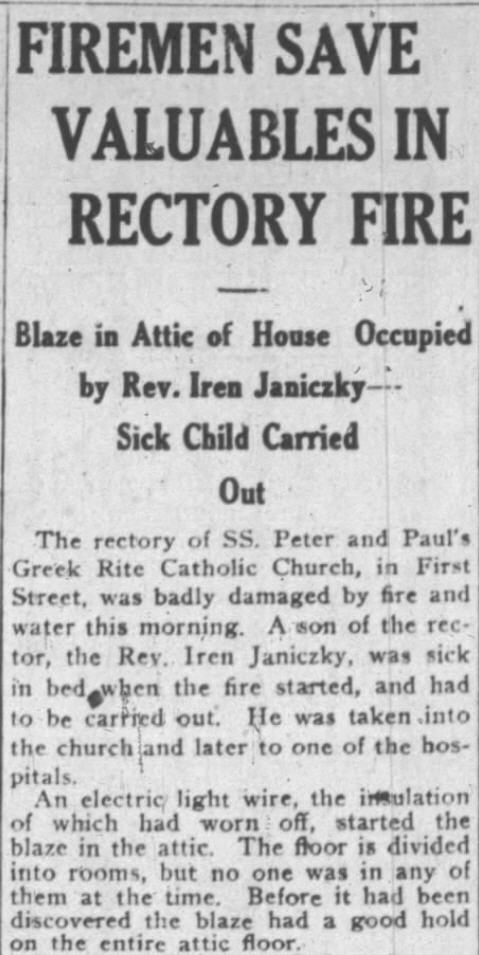
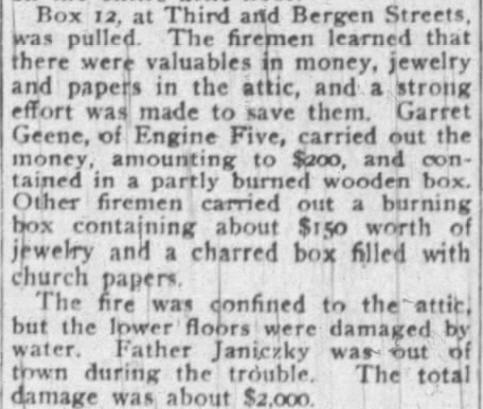
Passaic Daily Herald, Saturday, July 13, 1912
SQUABBLE IN GREEK CHURCH Vice Chancellor Denies Motion To Throw Out Bill Of Complaint
Counsel for George Piries and fifty other members of the Third Street SS. Peter and Paul's Greek Catholic church of Passaic, received an opinion from Vice Chancellor Stevenson in which he denies the motion of counsel for the First Russian Slavonic Greek Catholic Benevolent Society, under the Protectorate of Archangel St. Michael to throw out the bill of complaint in a Chancery Suit instituted by the Third Street church members of the society. Willima V. Rosenkrans, Michael Dunn and A.D. Sullivan are counsel for the Third Street church and Lefferts & Lefferts represent the society. The suit was brought as a result of a church squabble. The society, which is the defendant in the above action, is composed almost chiefly of members from the First Street, St. Michael's church of this city. These swear allegiance to the Holy See while the Third Street members are sworn to the Eastern Church under the domination of the Czar of Russia. The society was organized with members of both churches on the rolls but later the First Street members got into power and so changed the rules and regulations by amending them that it was impossible for a Third Street church member to get in unless he changed his faith. Inasmuch as many of the Third Street men had paid a tidy sum into the benevolent society they objected to being forced out in this way and for this reason started a suite in the court of chancery praying that a restraining order be issued enjoining the officers of the society from distributing any of the funds in their hands and that a receiver be appointed and that an equitable division of the funds be made.
To this bill of complaint, counsel for the First Street church objected on the ground of want of equity and because he held the bill did not set forth facts to justify the appointment of a receiver. Arguments on the petition for dismissal were heard before Vice Chancellor Stevenson on April 30th in Newark. The troubles between Piries, who really voiced the sentiment of the Third Street church, and the society, was due to the difference of faith between the two bodies. The society was formed in 1902 as a voluntary association with bylaws and rules and regulations with the object of helping the sick members and, in case of death, to give decent burial. Under the original constitution, membership in the society was constituted of men speaking a Slavonic language and belonging to either the Greek or Roman Catholic faith. The assets of the society now aggregate $40,000. Three years ago, the element forming the First Street church grew to be the majority in the society, elected their own officers and received full control. The First Street church members then tried to get the members of the Third Street church to foreswear their allegiance to the Eastern Church and take up with the Holy See at Rome. They were given the choice of doing this, it is alleged in the bill of complaint, or of getting out of the society altogether. Inasmuch as many of the members who were affiliated with the Third Street church and had been with the society since it was formed were now too old to obtain insurance in any other society and had paid into the fund approximately $12,000 in all such a threat as being removed from the benefits to which thy felt themselves entitled was a serious matter. Under the constitution and bylaws of the society a member was entitled to $300 upon the death of his wife, if he were in good standing, and a woman $600 in the event of the death of her husband, with the same condition prevailing. In case of sickness the member received $5 per week.
After many meetings a final meeting was held on June 10, 1911, at this Joseph Lefferts of Lefferts & Lefferts appearing for the First Street church, called the roll and put on record the wishes of each member as to whether he would cling to the old faith or join the new. Those who were not willing to disassociate themselves with the Third Street church were excluded thereafter from the meetings, the bill of complaint says, although they had paid their dues up to the last. If members of the Third Street church had been willing to affiliate themselves with the First Street congregation they might have still been members of the society and drawn benefits in case of sickness or death. After this action was taken, Piries acting for the fifty excluded members filed a bill in the court of chancery praying for relief. The defendants number about two hundred.
Passaic Daily Herald, Monday, October 4, 1920
GREEK CATHOLIC PRIEST is Given Warm Welcome Father Nevicky, From Rusin Town of UJAK, Home of Many Local People Greeted by St. Michael's Men Give Relief Fund
Memories of their homeland under the shadow of the Carpathian Mountains and tales of their home folk in Ujak, a little town of Podkarpatska Rusinia, were brought across the Atlantic yesterday to parishioners of St. Michael's Greek Rite Catholic Church, of Third Street, by the Rev. Emilian Nevicky eleven years the pastor of the Greek Catholic Church in Ujak. Father Nevicky came here yesterday on a tour of the United States, having spoken in sixty communities. He arrived in America on June 19, and will leave for his native land at the end of this month. He said Mass at St. Michael’s yesterday morning, spoke at a public meeting in St. Nicholas auditorium in the afternoon and was the guest at a dinner in the Hygeia hotel in the evening. The town of Ujak is linked to Passaic by the Uhro-Rusin people who left there to immigrate to the United States. Fifty percent of the parish of St. Michael’s came from Ujak. Hence the visit of Father Nevicky was an event of unusual interest. A man who had come to Passaic from that town, only a few weeks ago, was surprised and delighted to meet his former pastor here.
PODKARPATSKA RUSINIA
Podkarpatska Rusinia means in the American language literally, "Little Russia beyond the Carpathians". The Greek Catholic people of those provinces, like many other nationalities, are dissatisfied with the arbitrary dismemberment of the old nations and the creation of new by the Peace Conference in Paris. Formerly in a part of the Republic of Czecho-Slovakia, with a civil governor appointed by President Masaryk with the assent of the Peace Conference, a Pittsburgh lawyer, Dr. Gregory Zsatkovicz. At the meeting in St. Nicholas auditorium yesterday afternoon, resolutions were passed, addressed to the Czecho-Slovakian government calling for the unification of all Rusins, asking for government of the Rusin peoples by Rusins only and demanding the removal of "all stranger vagabonds." This is the self-determination program of these people. The capital of the Rusin provinces is Uzhorod, about 100 miles from Ujak. The Population numbers one and one-half million. The Rev. Michael Jackovics, pastor of St. Michael’s, was chairman of the meeting with was opened by Mayor John M. McGuire. John Kelly spoke in English making reference to Thursday night meeting this week at the high school. The Rev. Thomas J. Kernan, pastor of St. Nicholas’ expressed a sympathy for the people at the meeting in their desire for self-determination for their native land, promised to urge his parish to contribute to the relief fund and make an appeal for a large representation in next Sunday’s Holy Name parade. A collection was taken for the relief of the people of Podkarpatska Rusinia. Others who spoke in the Little Russian tongue were Father Nevicky, the visiting priest, the Rev. Leo Lewisicky, pastor of St. Nicholas Ukrainian Greek Catholic church, John Miklus, of Garfield and John Julak, 88 Hope Avenue. The speakers recalled memories of their native land and stressed the necessity for relief work now. Father Nevicky told of the seventy-five churches that were burned there, of the desolation and want after the Russian army occupation of 1915, of the gleam of hope held out to them in President Wilson’s "fourteen points" and the final dissolution of that dream of freedom. Father Jacovics headed the committee of arrangements assisted by Michael Kudla, recording secretary; Michael Fedush, financial secretary; Michael Mucha; treasurer; Joseph Gagyo; Michael Nebesnyak; John Miklus; Joseph Orechovsky; Frank Hazuda; John Takach; John Surgent; Nicholas Kovalycsik; Peter Kovalycsik; Michael Antonyk; Nicholas Lazorchik; John Dolyak; Hriczov Lukacs and Joseph Pavlick. The choir of St. Michael’s under Ignatius Palazy, choirmaster, was a delight. The numbers were: "The Star Spangled Banner;" a hymn "Daleka" a patriotic song "Zaruss" and another, "Bratia Valavijte." The members of St. Michael’s choir are: Marie Guback; Anne Lulak; Elizabeth Kotcher; Anna Murcko; Anna Lopuch; Anna Besaha; Anna Timochko; Anna Marckovich; Anna Gubak; Ela Kotcher; Marie Gernath; Maria Murcko; Anna Sedlack; Marie Lanosky; Anna Mucha; Marie Halushka; Helen Lelya; Catran Mulik; Anna Babyak; John Artim; John Sardich; Joseph Orechovsky; John Miklus; John Mushka; Michael Ziga; John Takach; Joseph Pavilik; John Surgent; Michael Lanosky; John Besaha; Nicholas Kovalycsik; John Jurchishin and George Stefancic.
Passaic Daily Herald, Monday, October 7, 1929
Peter Kovalycsik, Only Ill A Day, Called By Death
Resided in Eastside for the Past Fifty-Five Years – Funeral Tomorrow Morning
Peter Kovalycsik, eighty-four years old of 86 Second Street, husband of the late Mrs. Elizabeth Kovalycsik, died at 5 o’clock Saturday afternoon at the Passaic General Hospital after an illness of only one day.
Here Fifty-Five Years
The sudden death of the prominent Eastside billiard and bowling alley proprietor, was received with shock by his many friends. For thirty-two years he was proprietor of the café at 86 Second Street, but when the Prohibition Act became effective, he had his premises remodeled to make room for the indoor sport academy. Mr. Kovalycsik was born in Austria* and came to this country fifty-five years ago. He resided in this city since his arrival here. His name had become known to hundreds of followers of the indoor sports and whenever bowling was the subject, “Kovalycsik’s Alleys” was invariably first to be mentioned. Mr. Kovalycsik is survived by three sons, Peter Jr., Daniel and Nicholas Kovalycsik of 11 Westminster Place; two brothers, Nicholas Kovalycsik of Garfield and Joseph Kovalycsik of Fourth Street, Passaic. ** Eleven grandchildren also survive him, Helen, Nicholas and John Kovalycsik, children of the late Steven Kovalycsik, Olga, Alex, Samuel, Irene and Emil Kravchak, children of the late Mrs. Rose Kravchak; Dolly and Rose Kovalycsik, daughters of Daniel Kovalycsik and Helen and Daniel Kovalycsik, children of Nicholas Kovalycsik.
Organized Saint Michael’s Church
In addition to being one of the organizers of Saint Michael’s Greek Catholic Church of Passaic, Mr. Kovalycsik was also instrumental in organizing Saint Michael’s Benefit Society. He was a member of Saint Joseph’s Society and Saint Dimitri’s Society.
Funeral services will be held at 9 o’clock tomorrow morning from the home 96 Second Street and a 9:30 o’clock at Saint Michael’s Greek Catholic Church where a solemn High Mass of requiem will be celebrated. Father Burg of Bayonne, Father Chilla of Brooklyn, Father Marczinko of Pittsburgh, Pennsylvania, Secretary to the Bishop of that Diocese and a priest from Jersey City, all personal friends of Mr. Kovalycsik, will assist at the Mass. Interment will follow in Saint Peter’s Cemetery, Lodi.
*Born in Ujak, Saros County, Austro-Hungarian Empire. Present Day Udol, Stara Lubovna District, Slovakia.
**He was also survived by a sister, Mrs. Stephen (Anna) Sokol of Passaic and Willimantic, Connecticut.
Dedication of Saint Michaels Church Auditorium
The original Saint Michael's social hall/auditorium on Bergen Street was utilized for many years for various functions and teaching religious education to children of the parish. The one story wooden structure had a large window on the right and left of the two door entrance. Above the main door way was a circular stained glass window. On top of the building was a small angular steeple with a three bar cross.
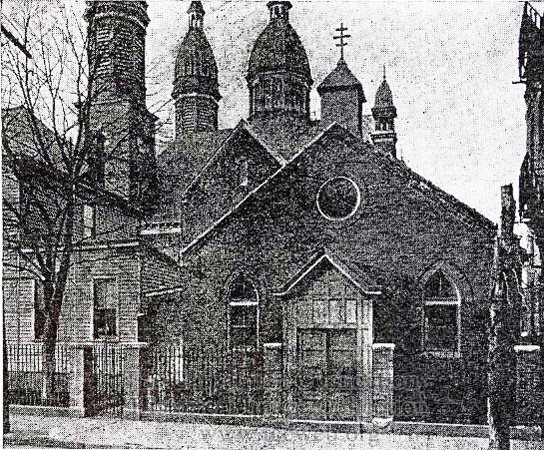
In 1935, St. Michael's resident priest, Father Michael Jackovics realized that a replacement of the wooden social hall was vital to the needs of his rapidly expanding parish. However, the construction of a new auditorium was a massive undertaking at a time of terrible economic depression. Father Jackovics inquired if each family of Saint Michael’s would consider offering a monetary pledge to cover the building costs. Saint Michael’s parishioners rose to the occasion and the project began. The new brick three story building was constructed on the same location as the original hall on Bergen Street. Through the front entrance, two staircases were placed one to the left and to the right. This gave access to the main floor auditorium. One floor further up held the choir loft area. One floor below at basement level there was a kitchen, bar area, restrooms and cloak room. The auditorium had a wooden floor, a stage for functions, a modern heating/lighting system and large windows which permitted natural sunlight to flood the interior.
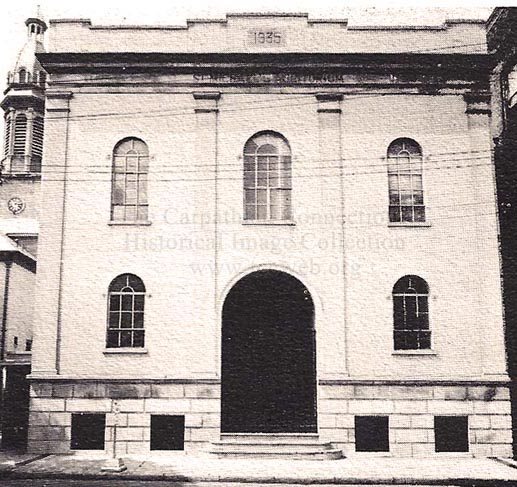
The auditorium was constructed and finished within the year. The new building was dedicated on Sunday, September 13, 1936. A Pontifical Mass was held in the Slavonic language at 10:30 a.m. Bishop Basil Takach was the main celebrant along with Father Michael Jackovics. Con-celebrants were Reverend Stephen S. Gulovich, D.D., from Saint Michael’s Greek Catholic Church, Allentown Pennsylvania, Very Rev. Basil Beretz of Saint Nicholas Greek Catholic Church, Yonkers, New York and Father Antonin Ulanitsky of Saint Nicholas Ukrainian Catholic Church, Passaic, New Jersey. Rev. John Slivka of Rahway, New Jersey served as Deacon and Rev. David Medveczky was the Sub-deacon. Various altar boys were in attendance; those who were attendants specifically to Bishop Takach were Peter Knapik, William Tulenko, Michael Dubrawsky and Nicholas Anderson. The Torch Bearers were Michael Knapp, Michael Sovich, Michael Dubrawsky and Nicholas Anderson. Leading the procession was a Cross Bearer, Alexis McIntyre. An address to the congregation in Rusnak was given by Bishop Takach and one in English by Father Fidelis Quinn, O.Cap.M. The managing committee for this event was overseen by Chairman, Mr. John Biss; Assistant Chairman, Mr. John Kundra; Secretary, Mr. Peter Zurichin; Treasurer, Mr. Joseph Popadich; and Ticket Officer, Mr. Peter Chrapco.
The Refreshment committee consisted of Mr. John Chigas, Mr. Nicholas Kovalycsik, Mr. Stephen Roman, Mr. John Scserbak, Mr. Michael Zeleznik, Miss Mary Onufer and Mr. Michael Giba. The following parishioners served the refreshments: Mrs. Anna Andrisin, Mrs. Anna Babyak, Mrs. Anna Galgola, Mrs. Julia Sabol, Miss Olga Haldik, Miss Helen Junda, Miss Margaret Junda, Miss Helen Kosteky, Miss Julia Lelyo, Miss Anna Csanda, Miss Helen Timochko and Miss Mary Zurichin.
The choir of Saint Michael’s Greek Catholic church sang magnificent a cappella responses during the Pontifical Divine Liturgy. Some of the selections were compositions of church liturgical music written by composers Bortnansky, Davidowsky, Zhdnaff, Sicinsky and Ostroglaszov. Other portions of the Mass were chanted in traditional Prostopenije (Plain Chant). The choir’s first selection was a prelude “Vosnesu Tja: (I Will Extol Thee O Lord) was sung solemnly prior to the start of the Pontifical Mass. The director of the choir was Professor Anthony Racin and the music librarian of the choir was Mr. George Anderson. Saint Michael’s Choir at this time had 57 highly talented members. The following were members of the choir who sang at the dedication services: Sopranos: Mary Beim, Verne Derkacs, Helen Janosko, Helen Kosteky, Helene Kovalyak, Mary Lozen, Eugenia Markulin, Mary Bee Pertuska, Irene Plavchan, Eleanor Radivojsic, Anna Csanda, Marianna Stefanco, Mary E. Timko, Eleanor Tulenko, Mary Tulenko, Tatiana Turok, Helena B. Zimmerman. Altos: Anne Chwan, Mary Derkacs, Anna Fedor, Anna Gladis, Olga Hladik, Irene Jadro, Mary Kostecky, Anne M. Odoksta, Julia Seventko, Helaine Seventko, Anna Strauss, Julia Waypa, Sophia Waypa. Tenors: Joseph Gaydos, George Herzo, John Herzo, Nicholas Kovalycsik, Alexis McIntyre, Frank Ordos, Joseph Pavlick, Michael C. Plavchan, Paul Racin, Thomas Racin, Michael B. Scserbak, Joseph M. Seventko, Nicholas Stepien, John Scserbak. Basses: George Anderson, George Arvay, Nicholas Bankpo, Ernest E. Blanche, Peter Dikun, Michael Dikun, George Gyongya, Steve Michael, Joachim Racin, Theodozy Racin, John Sabo, George Seventko, Michael Timko and Michael Vasel. After the Mass and dedication, a luncheon was served in the new auditorium. The procession to the hall was led by the choir who sang “Voskiliknite Hospodevi” (Sing Joyfully unto the Lord).
The new auditorium was rented out to both parishioners and non-parishioners. It was and still is utilized for wedding receptions, baptism celebrations, funeral repasts, dances and private family functions.
St. Michael's Church Bells (YouTube)
Bishop Andrew Pataki's Funeral (YouTube)
A Beloved Centuries Old Tradition
Saint John’s Ukrainian Greek Catholic Church in the Ternopil Region of Ukraine, August 2017 - The Benediction of the Blessed Sacrament.
This video is an example of a beloved tradition that also took place at Saint Michael’s Byzantine Catholic Cathedral in Passaic and all Greek (Byzantine) Catholic Churches in the U.S.
This service, modified from the Roman Catholic tradition with a monstrance, utilizes a reserved sacrament that is in a chalice with a covering. The covering for Saint Michael’s Chalice was a white silk cloth with the letters XB for Christos Voskrese or Christ is Risen stitched in gold thread. The top of the chalice had a small circular golden cover with a cross on top. Benediction of the Blessed Sacrament services were held throughout the year and as the faithful would all kneel, the priest would bless them with the Blessed Sacrament. This service, while abbreviated, was always held on Good Friday after the placing of the Plaschanicja in the grave. The Blessed Sacrament would remain on the altar for veneration by the faithful until Holy Saturday night. It is interesting to know that in Slovakia, Benediction of the Blessed Sacrament is still a service that is said for the faithful, especially at pilgrimages, the most important being in Litmanova. The service held in Litmanova, Eastern Slovakia does utilize a monstrance that has been adapted for the Greek Catholic Blessed Sacrament (the Roman Rite has a round host while Greek (Byzantine) Catholics utilize a square one).
Stations of the Cross
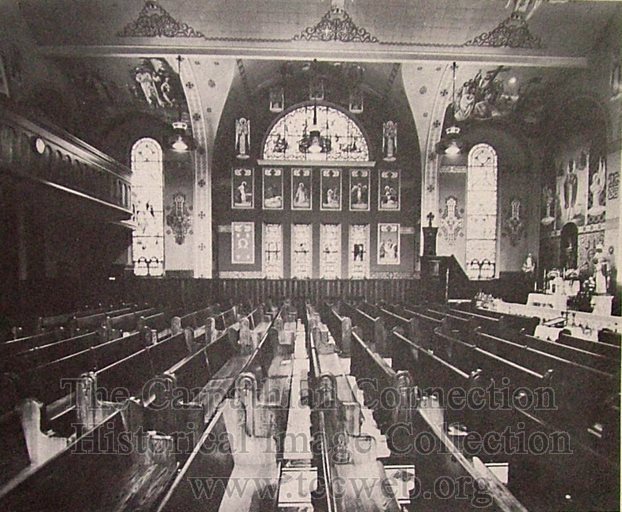
With donations from the faithful parishioners of St. Michael's the Stations of the Cross stained-glass windows were begun in 1945. The windows were completed with the renovation of the church interior in 1953. It is unclear as to when and why these beautiful stained-glass depictions of the Stations of the Cross were bricked up. They were replaced with murals of the Stations of the Cross which have since been discarded.
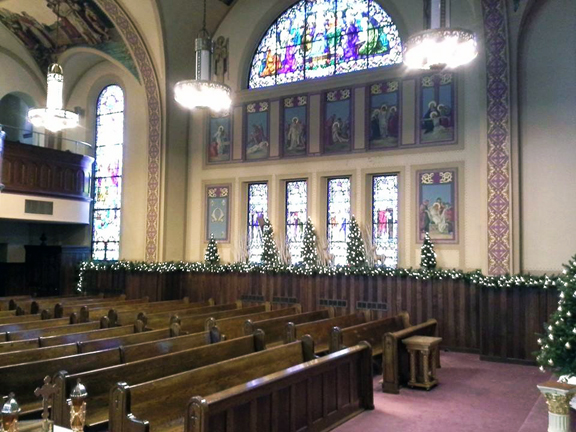
Every Lent, the Stations of the Cross were one of the main devotions at the Cathedral. Clergy would move from one station to the next while the faithful would pray with him. After parishioners received Holy Communion many found great comfort passing each station as they said their private prayers on the way back to their pews. It is a shame that the Stations of the Cross (stained-glass and later murals) that graced the walls of the Cathedral for over 64 years, are now only a memory.
Clergy, Cantors and Religious Educators
Reverend Father Michael Jackovics, 1875-1949
Photo Circa 1918
.jpg)


Father Michael Jackovics was born in the village of Puznyak-Falva in the Austro-Hungarian Empire on January 24, 1875. He came from a very long and distinguished line of Greek Catholic clergy. His father had been a Greek Catholic priest and for seven generations his family had been Greek Catholic clergy. Father Jackovics was educated in the high school which was located in Ungvar (present day Uzhhorod, Ukraine) and upon completion entered University in the same city. He was ordained a Greek Catholic priest when he was twenty-three years old by the Right Reverend Julius Firczak, Bishop of the Munkacs diocese. He was an assistant priest in Hust which was one of the larger congregations within the entire diocese. Father Jackovics arrived in the United States and originally settled in Bridgeport, Connecticut. After Bridgeport, he was assigned to Lansford, Pennsylvania and in 1902, was offered an invitation by the Right Reverend M. J. Hoban, Bishop of Scranton, Pennsylvania to take charge of Saint John the Baptist Greek Catholic church. During 1908, Father Jackovics was elected spiritual director of the Greek Catholic Union of the United States which had over 100,000 members. Father Jackovics, as was the long standing custom in the Greek Catholic church, had married before ordination. He was married in Makaria, Austro-Hungary to Yolanda Kaminsky. Yolanda Kaminsky was also from a priestly family. Her father was stationed in the United States as rector at a Greek Catholic church. During 1918, the Very Reverend Martyak, Apostolic Administrator of the Greek Catholic church in the United States appointed Father Michael Jackovics to administer Saint Michael's church (later Cathedral) in Passaic, New Jersey. Father Michael Jackovics had previously served at Saint John the Baptist Greek Catholic church in Scranton, Pennsylvania for sixteen years. When Father Jackovics arrived in Passaic, Saint Michael's membership had swelled to over 3,000 members. Father Jackovics was a hard working priest and competent administrator. Under his tenure two rooms were converted for school instruction use and various renovations and expansions were conducted with his guidance. During Father Jackovics' long tenure, many improvements and expansions would be seen. He opened the first official part of a cemetery for Saint Michael's in 1921 and consecrated the remaining ground in 1936. He was also instrumental in the construction of a modern rectory and church Auditorium which are still utilized by the Saint Michael's Cathedral today. At the time of his death on December 7, 1949, Father Jackovics was survived by his wife, Pani Yolanda and his children, Thomas, Joseph, Michael, Yolanda and Theodore.
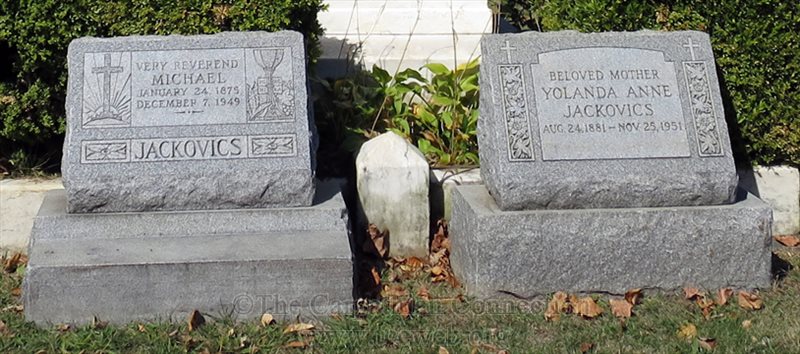
Cards that were distrubuted to parishioners by Father Jackovics
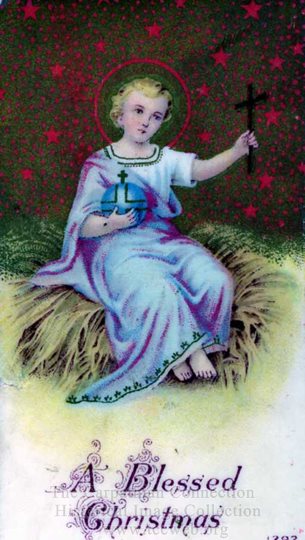
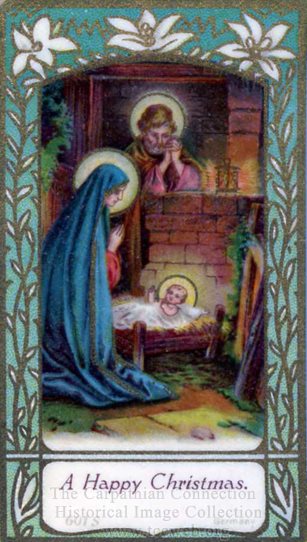
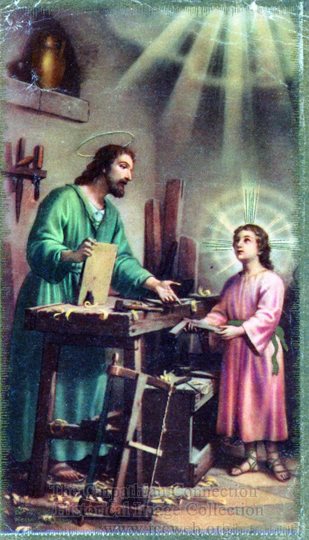
Rt. Reverend Monsignor George Durisin, V.G., V.F., 1920-1992
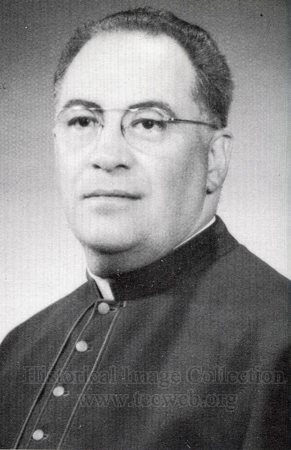
George Durisin was the son of George and Mary (Kizlin) Durisin. He was born on the 12th of August 1920 in Pittston, Pennsylvania. His father hailed from the village of Trebisov, Slovakia and served as a corporal in the Austro-Hungarian Army. George Sr., settled in Pittston and was employed as a foreman for the Lehigh Valley Rail Road Company No. 23. He married Mary Kizlin, a native of Pittston, on the 9th of June 1919. George and Mary were the proud parents of six children. They were devoted members of St. Michael’s (Greek) Byzantine Catholic Church, Pittston. Three children of George and Mary Durisin would enter religious life. Their son George Jr. was ordained a priest of the Byzantine Catholic Church. Their daughters Anna (Sister Paula) and Rita (Sister Philip) joined the Sisters of St. Basil the Great Byzantine Catholic Convent in Uniontown, Pennsylvania
.
Upon completion of his elementary and high school education, George, Jr. began the process of working towards the priesthood. At the time the Greek Catholic Church did not have a specific Greek Catholic Seminary so he attended Saint Procopius Roman Catholic Seminary in Lisle, Illinois. Upon completion of his seminary education he was ordained in the priesthood on November 13, 1945. From 1950 to 1964 he was assigned as pastor in Greek (Byzantine) Catholic churches in Old Forge, Pennsylvania, Cleveland, Ohio and Bridgeport, Connecticut. It was in January of 1964 while serving as pastor of St. John the Baptist Byzantine Catholic Church in Bridgeport and also as Diocesan Vicar General that Father Durisin was conferred the papal honor of Monsignor by Pope Paul VI. On August 4, 1964 he was assigned as the eighth resident pastor of St. Michael’s Byzantine Catholic Cathedral in Passaic, New Jersey. Monsignor Durisin began his work in earnest. He addressed necessary improvements to the church and parish house. Since St. Michael’s is the seat of the Bishop Monsignor included a Bishop’s throne as one of these upgrades. Monsignor helped to coordinate the celebration of the 75th anniversary of the founding of Saint Michael’s Cathedral which took place on October 31, 1965. He also undertook urgent repairs to the church cemetery and purchased additional property for the parish and school. Although these projects demanded a great deal of his time his parishioners spiritual and worldly needs came first. In the month of May he held special weekly services in honor of the Blessed Virgin Mary and each June he held a *Moleben in honor of the Sacred Heart of Jesus. He also established a “poor fund” available to those of his parish experiencing financial hardships.
During the 1960s Monsignor Durisin’s tenure was in full swing. He was elevated to the title of Vicar General of the Diocese. This position in the Bishop’s absence would require him to assume all of the Bishops responsibilities. He also served as a member of the Board of Consultors, Chairman of the Commission on Ecumenism, and as a member of the Board of Trustees for Saint Mary’s Catholic Hospital in Passaic. On May 8, 1966 the Cathedral began their first CCD program. Children of the parish would now receive religious instruction from ages of five to eighteen. Although he already had a full plate Monsignor Durisin took an active role with the CCD program and taught the high school grade level class.
November 8, 1970 marked the twenty fifth year since Monsignor Durisin was ordained. He celebrated his silver jubilee of ordination to the priesthood at Saint Michael’s Cathedral. He was a devoted priest to his beloved parishioners and was dedicated to conditions of the faith.
On November 9, 1980 the Cathedral celebrated its 90th anniversary and Bishop Michael Dudick blessed a new iconostasis. Many organizations and groups were formed during Monsignor Durisin’s tenure. The Byzantine Service Group was started to assist parishioners with a wide range of services, the Ladies Guild was organized, Saint Michael’s Parochial School celebrated its 25th anniversary and Professor John Kahanick was installed as Saint Michael’s full-time Cantor/Choirmaster. A new undertaking by Bishop Dudick and Monsignor Durisin was initiated in 1980 for the relocation of the Diocesan offices to a larger complex. In 1982 nineteen acres of wooded land on Lackawanna Avenue in West Paterson were purchased for this purpose. By 1987 this space would house the Chancery offices, Bishop’s residence, Heritage Museum and Saint Michael’s Chapel and social hall. The chapel site was blessed by Bishop Michael Dudick with Monsignor Durisin as co-celebrant on April 28, 1985. After construction and placing of the cornerstone, Saint Michael’s Chapel was blessed on May 31, 1987.
After faithfully serving Saint Michael’s Cathedral for almost 25 years, Monsignor Durisin was given the honor of being installed as the Director of Formation at Saints Cyril and Methodious Byzantine Catholic Seminary in Pittsburgh, Pennsylvania. After a brief period of time in this service he was promoted to the new position of Vice-Rector of the Seminary. While serving as Vice-Rector, Monsignor Durisin’s health began to deteriorate. On Sunday, October 11, 1992, after serving faithfully as a Byzantine Catholic priest for approximately 47 years, Monsignor Durisin passed away at the age of 72. At the date of his death, he was survived by his brothers, Joseph and Paul, three sisters, Mary, Sister Philip, Sister Paula and several nieces and nephews. A Pontifical Requiem Divine Liturgy was held on Thursday, October 15, 1992 at the church of his baptism, Saint Michael’s in Pittston, Pennsylvania. He is interred at Saint Michael’s Byzantine Catholic cemetery in Pittston. The prayer card handed out at his wake denoted Monsignor Durisin’s last words “Blessed Be the Name of the Lord” which was a fitting epitaph for a devoted priest who loved the Byzantine Catholic Church.
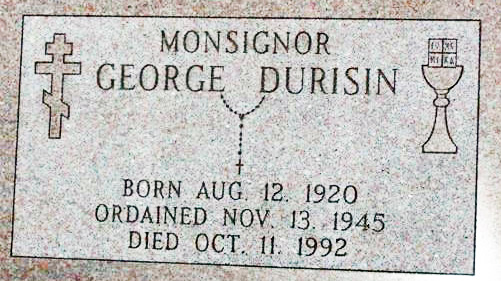 The simple cemetery monument identifying his final resting place has an engraved three bar cross on the left. To the right denoting his priestly status is a chalice with a host imprinted with ICXC. A rosary graces the middle between his name and the dates below it. The modest rose colored stone is engraved with Monsignor’s name, date of birth, date of ordination and date of death.
The simple cemetery monument identifying his final resting place has an engraved three bar cross on the left. To the right denoting his priestly status is a chalice with a host imprinted with ICXC. A rosary graces the middle between his name and the dates below it. The modest rose colored stone is engraved with Monsignor’s name, date of birth, date of ordination and date of death.
Monsignor George Durisin served the church, Saint Michael’s Cathedral, the faithful and his fellow clergy devotedly. He was a man of great humility and self-sacrifice. Even though many well earned titles and promotions were bestowed during his priestly vocation, Monsignor George Durisin’s dedication, integrity and hard work continue to inspire those who were fortunate to have had their lives touched by his example.
Professor Theodore Ratzin, 1879-1930
Professor Theodore Ratzin was a Greek Catholic Cantor/Choir Director who was trained in Europe. He was the son of John and Julia (Evans) Ratzin and served in numerous Greek Catholic (Byzantine Catholic) parishes on the East Coast. He served at Saint Michael's Greek Catholic (Byzantine Catholic) Church (later Cathedral) in Passaic, New Jersey and St. Mary's Greek Catholic (Byzantine Catholic) Church in Wilkes Barre, Pennsylvania. In 1920, Professor Ratzin composed his Divine Liturgy which was scored for four-part choir. This work was performed at Saint Michael's Cathedral in Passaic, NJ and at St. Mary's in Wilkes Barre, PA. In 1925 he compiled with Cyrillic text and published in Wilkes Barre a collection of Chant melodies entitled "Prostopinije". This collection incorporated music from the Bokshaj service books but also was expanded to include various Chants for the Greek Catholic Matins (morning) Service. This music is utilized to this day in the "Cantors' Companion" offered by the Byzantine Catholic Metropolitan Cantors' Institute, Pittsburgh, PA. Professor Ratzin passed away of pneumonia in 1930 and his son Anthony and grandson Theodore also followed in his footsteps as Cantor/Choir Director/musicians. He is interred at St. Mary's Byzantine Catholic Cemetery in Dallas, Pennsylvania.
Findagrave Photos by, Paul Babiuk (#47278763)
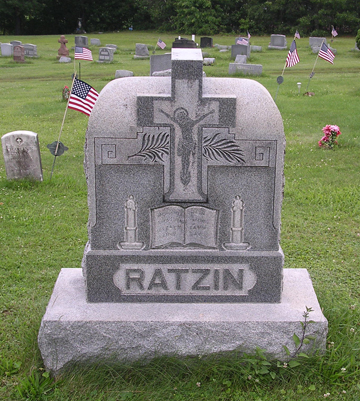
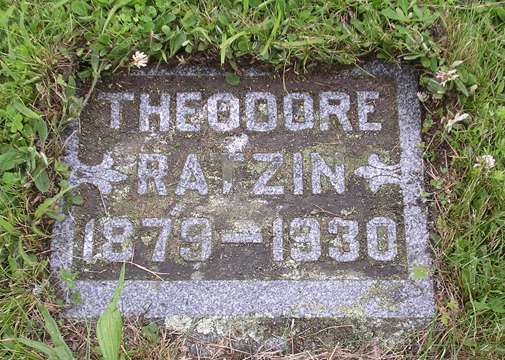
Cantor Julius Dobra, 1881-1944
Cantor at St. Michael's Greek Catholic Church from 1907-1916
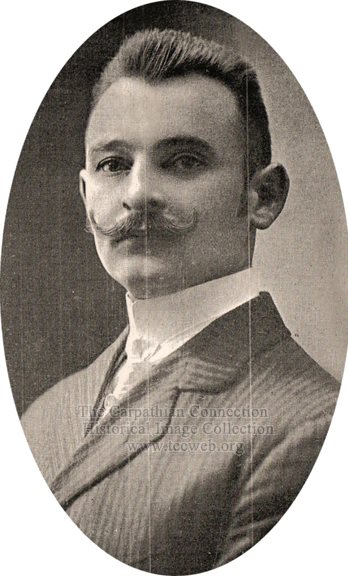
Cantor Dobra (right of priest)
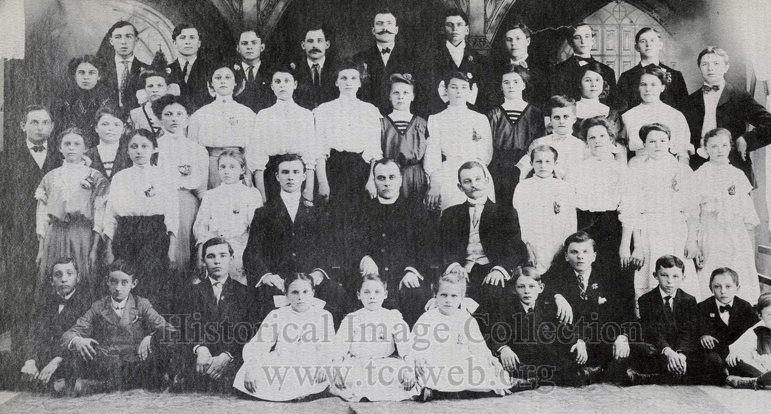
Findagrave Photo by, Virginia (#47379955)
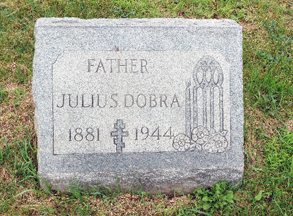
Cantor Dobra served as Cantor of St. Michael's Greek Catholic Church from 1907-1916. He later served as Cantor at St. John's Byzantine Catholic Church in Hazleton.
He was the son of Anthony & Gizella (Washko) Dobra. He died in Hazleton, Pennsylvania in 1944 and is interred at St. John's Byzantine Catholic Church in Hazleton.
Professor Ignac Pelazzi
Cantor at St. Michael's Greek Catholic Church prior to 1919 to 1925.
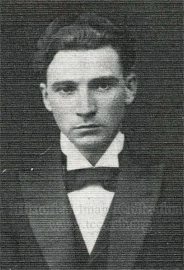
Professor Ignac Pelazzi, Father Jackovics and Choir 1919. Nicholas Kovalycsik in back row 7th from left.
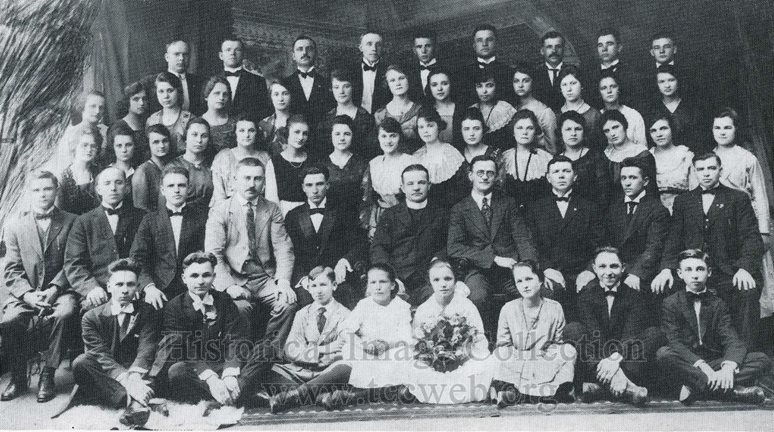
Professor Korposch
Cantor at St. Michael's Greek Catholic Church in 1925.
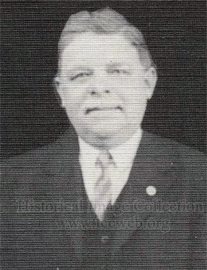
Professor Anthony Racin, 1905-1954
Cantor at St. Michael's Greek Catholic Church from 1927-1954
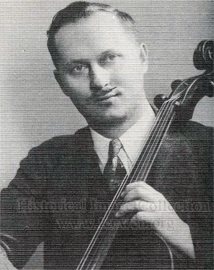
Professor Racin, Father Jackovics and Choir Circa 1928
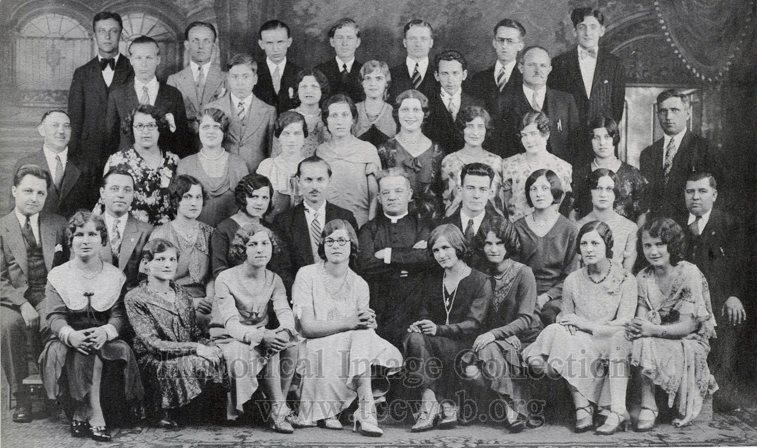
Grave Photo by, Joy E. Kovalycsik
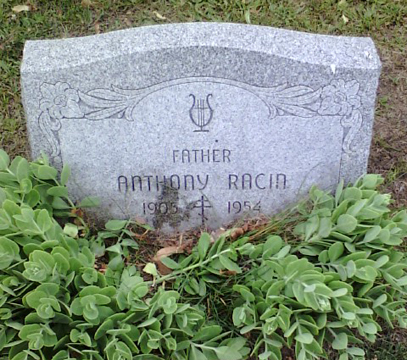
Professor Anthony Racin was the son of Professor Theodore Ratzin and Ann (Kupar) Ratzin. He faithfully served St. Michael the Archangel Greek Catholic Church (St. Michael's Byzantine Catholic Cathedral) as cantor/choirmaster for almost 3 decades, from 1927 until his death in 1954. He was the husband of the former, Margaret Hladik. Interred at St. Michael's Cemetery in South Hackensack, New Jersey.
Cantor George Anderson, 1912-1984
Cantor at St. Michael's Greek Catholic Church from 1954-1966
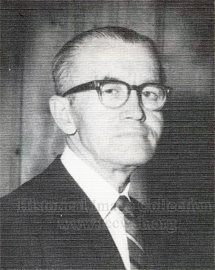
Cantor Anderson with Msgr. Durisin and Choir in 1965
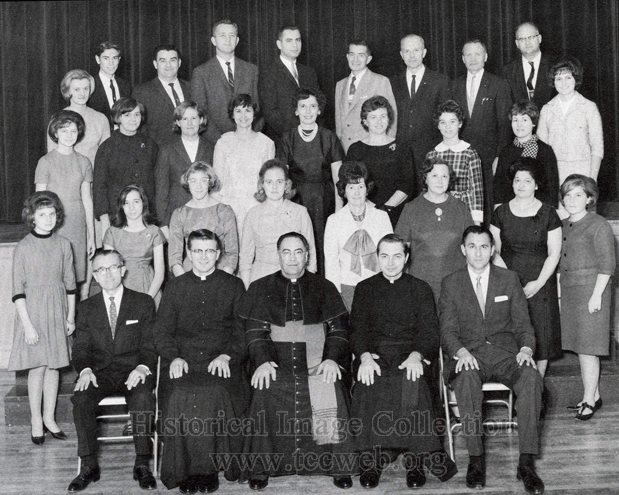
Grave Photo by, Joy E. Kovalycsik

Interred at St. Michael's Cemetery in South Hackensack, New Jersey.
Cantor Joseph Kovalik, 1928-1988
Cantor at St. Michael's Greek Catholic Church from 1968-1972
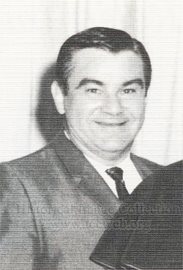
Grave Photo by, Joy E. Kovalycsik
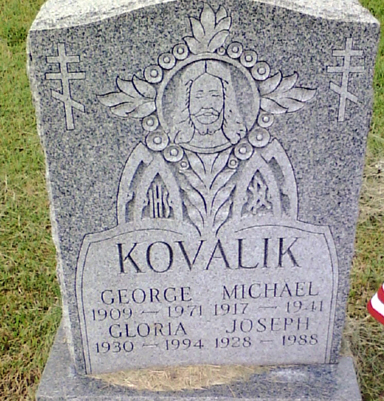
Interred at St. Michael's Cemetery in South Hackensack, New Jersey.
Cantor Paul Bereznak, 1910-1980
Cantor at St. Michael's Greek Catholic Church from 1972-1979
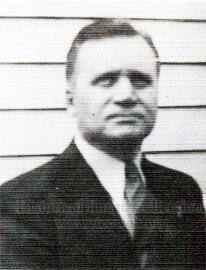
Grave Photo by, Joy E. Kovalycsik
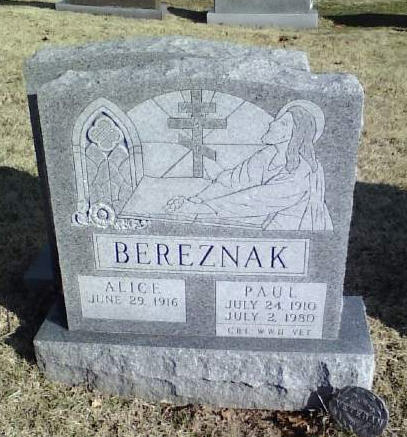
Interred at St. Michael's Cemetery in South Hackensack, New Jersey.
Professor John Kahanick, 1914-1998
Cantor and Choir Director
at St. Michael's Greek Catholic Church from 1979-1998
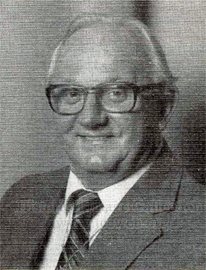
Professor John Kahanick was born in 1914 in Dunmore, Lackawanna County, Pennsylvania. He was one of eight children born to immigrant parents Stephen and Anna (Wozniak) Kahanick. His father supported the family by working in the local coal mine and his mother was a homemaker.
Inspired by the Slavonic Chant of his Greek (Byzantine) Catholic Religion Mr. Kahanick began studying choir singing on his own. It was not long before he was training others and forming junior and senior choirs at churches throughout Pennsylvania. Encouraged by his natural gift he later went on to study at the University of Minnesota where he received a degree in music. After graduation he trained for the opera. However, he decided that choir leadership was where his heart was at. Professor Kahanick was a skilled and talented tenor. He had a flawless execution of the music and accurate timing while chanting the epistle. He penned many compositions and arrangements of various melodies and historical “Prostopinije” chants. He had a full knowledge of Slavonic and knew the benefit of translating these timeless hymns and chants.
After serving a number of churches in Pennsylvania, Professor Kahanick spent eight years forming choir. Later he served at St. John the Baptist Byzantine Catholic Church in Minneapolis. After this, he served Saint Michael’s Byzantine Catholic Church in Gary, Indiana. While in the Midwest, Professor Kahanick continued to organize church choirs. Some of these choirs were organized in East Chicago, Whiting, Hammond, Indiana, Joliet and Chicago, Illinois. His true genius was for composition and arrangements. It did not take long for word to circulate he was a genuine artist. Clergy, cantors, choir directors and choir members sought out Professor Kahanick from all areas of the United States. It gave him great pleasure to assist other Cantors and Choir Directors expand the scope of their choral musical endeavors.
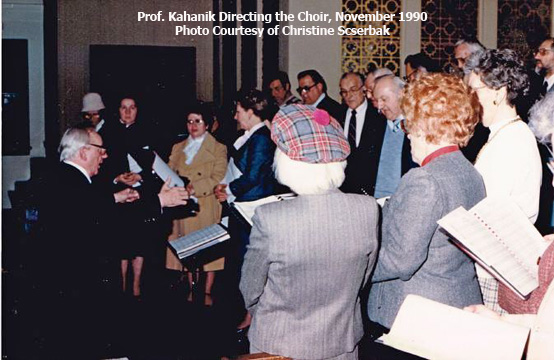 On September 10, 1979 Professor Kahanick began his tenure at Saint Michael’s Byzantine Catholic Cathedral as their Cantor/Choirmaster. He would remain in this position until his death on March 2, 1988. Professor Kahanick was devoted to the Byzantine Catholic Church and the art of Prostopinije chant. In his later years to those expressing an interest in becoming a cantor he was known to remark “it is a life of sacrifice.”
On September 10, 1979 Professor Kahanick began his tenure at Saint Michael’s Byzantine Catholic Cathedral as their Cantor/Choirmaster. He would remain in this position until his death on March 2, 1988. Professor Kahanick was devoted to the Byzantine Catholic Church and the art of Prostopinije chant. In his later years to those expressing an interest in becoming a cantor he was known to remark “it is a life of sacrifice.”
The settings for all his scores and arrangements were kept within the traditional harmony manner for Carpatho-Rusyn plain chant. The arrangements, compositions and original scores he created are too numerous to mention. He also translated and arranged music from Slavonic into English for Byzantine Catholic churches throughout the United States. One important composition is still performed today at Saint Michael’s Cathedral in Passaic. On the holy day of Saint Michael, the “Hymn to Saint Michael” is performed. All who have attended the Cathedral are familiar with the hymns opening words “Archangel Michael, Prince of all angels, Leader, defender, of the heav’nly hosts.” This hymn is greatly loved by many parishioners of Saint Michael’s Cathedral.
Professor Kahanick was well known within the Passaic area churches. A choir member of St. Michael’s Greek Catholic Orthodox Church in Binghamton, New York recalled Professor Kahanick’s arrangement for the hymn “Tichy Vecer.” He recalled it was performed in Professor Hilko’s repertoire of Saint John’s Russian Orthodox Church in Passaic. Professor Kahanik also scored music for four part choir (Soprano, Alto, Tenor, Bass.) He was well known for his hymn “Rejoice, O Purest Mother” (Veselisja Vo Cistot’i.) This hymn is a jewel in chant repertoire and is complete with six verses and refrain. This composition is utilized to this day. The original setting for this arrangement was scored by Professor Kahanick in June, 1978 along with dozens of other works. Another glorious composition was the solemn feast hymn for the leave taking of the Entrance of the Most Holy Theotokos and Ever-Virgin Mary into the Temple. Professor Kahanick wrote the text and lyrics; then gently wove them into the melody of “Beautiful Holy Queen” (Radujsja Carice).
Professor Kahanick knew sorrow during his tenure at Saint Michaels. His beloved wife Mary Kahanick nee Fatula passed away in 1993. Perhaps a testament to his faith and talent he continued to serve for another five years after his wife’s death. Even as his own health declined he never neglected his duties as Cantor/Choir Director. His dedication was appreciated by all who knew him. During his tenure, the Cathedral offered a mass each Sunday at 6:45 a.m., 8 a.m., 10 a.m. (all Slavonic) and at 12 noon. This was his Sunday, singing and directing the choir from the very early hours of the morning until the early afternoon. As needed he also performed other services such as funerals, weddings, and other special services during the liturgical year. After a long life of service to his church and his art, Professor Kahanick succumbed to Congestive heart failure and died on March 2, 1998. His funeral Liturgy was held at Saint Michael’s Cathedral in Passaic on Friday, March 6, 1998.
During the Byzantine Catholic funeral service, a section professor would have performed is chanted. The Prokeimenon in Tone 6 states “Blessed is the way on which you go, O Soul, for a peaceful place has been prepared for you.” He was interred in Saint Michael’s Cathedral Cemetery. Professor Kahanick was survived at the time of his death by his brother George of Scranton, Pennsylvania, his sisters Pauline of Dunmore, Pennsylvania and Mary of New York City, nephews Michael Fatula and Michael Masich and nieces Doreen Fatula and Delia Lafferty.
Grave Photo by, Joy E. Kovalycsik
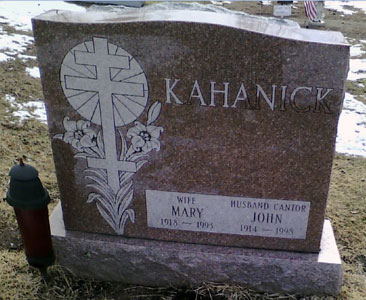 Today, individuals still stop by his grave and say a silent prayer for this devoted Cantor. Professor gave everything he had while remaining firm when it came to music and his art. His talent, smile and gentle demeanor graced Saint Michael’s Cathedral for many years. The words from Psalm 104 truly applied to his life: “I will sing to the Lord as long as I live; I will sing praise to my God while I have being.” Interred at St. Michael's Cemetery in South Hackensack, New Jersey.
Today, individuals still stop by his grave and say a silent prayer for this devoted Cantor. Professor gave everything he had while remaining firm when it came to music and his art. His talent, smile and gentle demeanor graced Saint Michael’s Cathedral for many years. The words from Psalm 104 truly applied to his life: “I will sing to the Lord as long as I live; I will sing praise to my God while I have being.” Interred at St. Michael's Cemetery in South Hackensack, New Jersey.
Mrs. Irene Serafin, 1925-1989
Ministry of the Educator
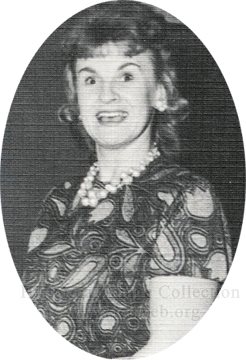
Mrs. Serafin provided many dedicated years of faithfull service to St. Michael's Byzantine Catholic Cathedral. She was the wife of Michael Serafin and daughter of Michael and Mary (Chanda) Fedor. Her father was born in the village of Sedlice, Slovakia. Her grandfather John Chanda was born in the Carpatho-Rusyn village of Ujak, Slovakia and her grandmother Julia Haschak was born in the neighboring Carpatho-Rusyn village of Maly Lipnik, Slovakia. She was an administrative assistant to the director of Catholic Family Community Services in Paterson, New Jersey and was a kindergarten teacher at the Cathedral of St. Michael the Archangel in Passaic, New Jersey. She was past president of the Clifton-Passaic Chapter of the National Council of Catholic Women and the St. Michael's Ladies Guild.
Vocations
Sister Irene (Julia) Hladik, O.S.B.M.
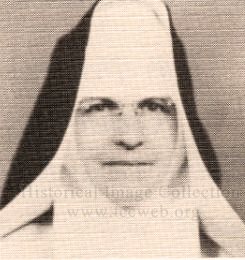
Sister Irene (Julia) Hladik was a vocation from Saint Michael’s Byzantine Catholic Cathedral, Passaic, New Jersey. She was born in Clifton, New Jersey on August 8, 1905 to John and Rose (Koziar) Hladik. Her father was from the village of Petrova, Slovakia and her mother was from Labowa, Galicia (Poland). She was baptized at Saint Michael’s Greek Catholic Church, Passaic on August 13, 1905 by Father Irenus Janitsky. She entered the Ukrainian Catholic Order of the Sisters of Saint Basil the Great in Philadelphia on December 28, 1925. She received her habit on May 9, 1926, made simple vows on June 12, 1927 and gave her solemn profession of vows on August 19, 1933. Sister Irene was a teacher and between the years 1926 to 1974 she served in various Parochial schools within the Ukrainian Catholic Archeparchy Philadelphia. She also taught students at Saint Basil’s Girls Academy in Jenkintown, PA. Prior to her death, she was the Librarian at Saint Basil’s Academy. A funeral Mass was held on December 9, 1974 at the convent’s Christ the King chapel with interment in the Ukrainian Catholic Sisters of Saint Basil convent cemetery.
Sister Matthew (Olga) Hladik, O.S.B.M.
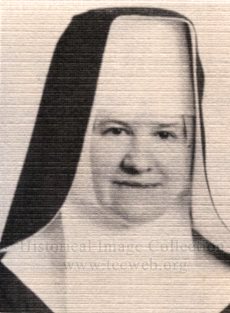
Sister Matthew (Olga) Hladik was a vocation from Saint Michael’s Byzantine Catholic Cathedral, Passaic. She was born in Clifton, New Jersey on July 1, 1914 to John and Rose (Koziar) Hladik. Her father was from the village of Petrova, Slovakia and her mother was from Labowa, Galicia (Poland). She entered the Byzantine Catholic order of the Sisters of Saint Basil the Great in Uniontown on January 24, 1948. She professed her first vows on December 9, 1949 and made her perpetual vows in the presence of Bishop Daniel Ivancho on August 28, 1953. Prior to entering religious life, Sister Matthew served in the United States Women’s Army Corps during World War II. She received a number of citations and was a Technician, Third Grade. She received her Bachelor of Science Degree in Education from Misericordia College and her Master of Science Degree in Secondary Education from Duquesne University. Sister taught elementary and secondary school grades. She also served two terms as Vicar General for the Sisters of Saint Basil the Great order and resided in Rome for a few years. During this period Sister Mathew had the honor of personally greeting Blessed Bishop Basil Hopko of Presov at the train station in Rome. Archbishop Stephen Kocisko had worked hard pressuring the communist government to release Bishop Hopko. Finally, they did and he was deported from Czechoslovakia. At the train station to meet him were Sister Matthew, Archbishop Stephen Kocisko and Mother Claudia. In later years, Sister Mathew served at Saint Michael’s Cathedral Parish office from 1968 to 1983. Sister Mathew Hladik passed away on October 13, 2006. Her funeral Mass was celebrated by Monsignor Russell A. Duker and other concelebrating clergy at the Sisters of Saint Basil Convent chapel with interment, including full military honors, in the sisters section of Mt. Saint Macrina cemetery, Uniontown, Pennsylvania.
Sister Mary Marguerite Babyak, O.S.F.
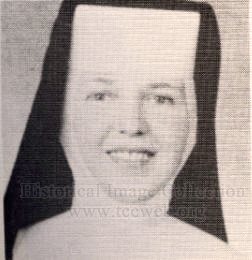
Sister Mary Marguerite Babyak was a vocation from Saint Michael’s Byzantine Catholic Cathedral, Passaic. She entered the Slovak Roman Catholic Order of the Daughters of Saint Francis at Saint Joseph’s Convent in Lacon, Illinois.
Sister Mary Thaddeus Mulick O.S.F.
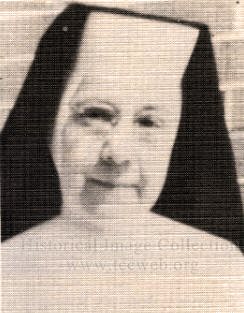
Sister Mary Thaddeus Mulick was a vocation from Saint Michael’s Byzantine Catholic Cathedral, Passaic. She entered the Slovak Roman Catholic Order of the Daughters of Saint Francis at Saint Joseph’s Convent in Lacon, Illinois.
Sister Mary Elizabeth Pristas, S.C.T.
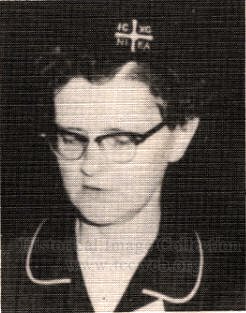
Sister Mary Elizabeth (Margaret) Pristas was a vocation from Saint Michael’s Byzantine Catholic Cathedral, Passaic, New Jersey. She was the daughter of Michael and Anna (Yurake) Pristas. Sister Mary Elizabeth entered the Order of the Sisters of Christ the Teacher in Pittsburgh, Pennsylvania on Sunday, March 25, 1962 at 4 p.m. This was a new order formed by Bishop Elko in 1959 for Byzantine Catholic nuns. Sister Mary Elizabeth made her first profession of vows with two other postulants, Helen Kollar from Lakewood, Ohio and Lillian Hvozdovich from Pittsburgh, Pennsylvania. A solemn Pontifical Mass and service of acceptance was offered by Bishop Nicholas Elko, Monsignor Daniel P. Maczkov and Monsignor John S. Kocisko. The new order’s convent was located at the former Limbach Estate on Riverview Avenue in Pittsburgh. The Sisters of Christ the Teacher served in a number of parochial schools and churches as teachers and offered catechism instruction to children. One church they served at for a number of years was Holy Ghost Byzantine Catholic Church, McKees Rocks, Pennsylvania. Sister Mary Elizabeth Pristas served as a teacher at Saint John’s Ukrainian Catholic Church, South Side, Pittsburgh. Sister Mary Elizabeth died on July 9, 2005. Her funeral Mass was held at Saint Michael’s Byzantine Catholic Cathedral, Passaic with interment at Saint Michael’s Cemetery, South Hackensack.
Reverend James Mitchko
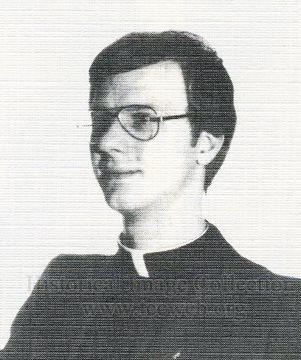
Father Mitchko is the son of the late, George A. and Olga (Schaefer) Mitchko.
Reverend Mitchko of Lincoln Park, New Jersey was ordained along with Reverend Charles Yastischock of Harrisburg, Pennsylvania on July 25, 1977 at St. Mary's Byzantine Catholic Church in Kingston, Pennsylvania by Bishop Michael Dudick and Bishop Thomas Dolinay of the Byzantine Catholic Diocese of Passaic, New Jersey.
The ordination was Bishop Dolinay's first since having been elevated to the episcopacy in November 1976 in Scranton, Pennsylvania.
In 1977 Father Mitchko was assigned as assistant pastor at St. Mary of Aussumption Byzantine Catholic Church in Wilkes-Barre, Pennsylvania.
The ordination was televised by Service Electric Cable TV of Allentown, Pennsylvania.
Archival Documentation & Photos
Diamond Jubilee
Front of medal states “St Michael’s Cathedral, Passaic, New Jersey, Diamond Jubilee 1890-1965”
Reverse has a small safety pin for attachment to clothing, it is imprinted with the Coat of Arms of Bishop Stephen John Kocisko.
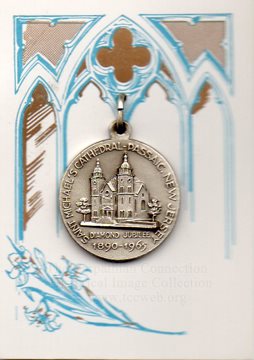
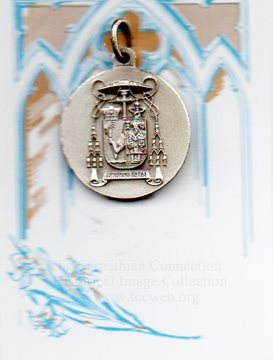
50th Anniversary of the Eparchy of Passaic
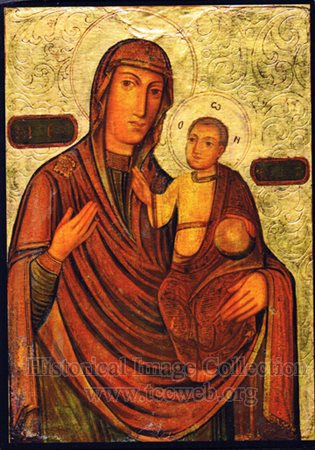
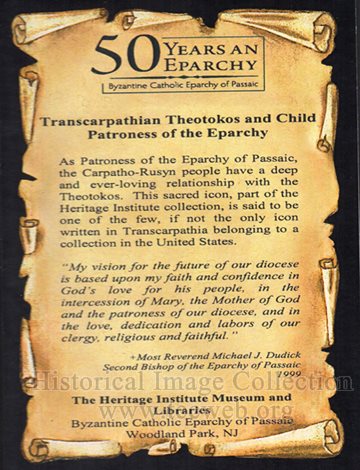
Greek Catholic Communion Prayer Card in English and Rusnak (Sponsored by St. Michael's Holy Name Society)

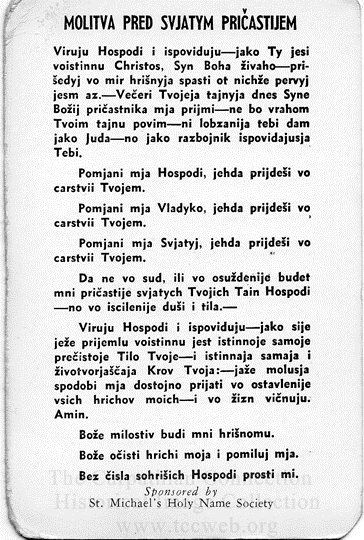
Early St. Michael's Greek Catholic Church Marriage Certificates
Entry #62
Date May 23, 1908
Groom Ference (Frank) Paulik son of Ference Paulik and Mary Pastor. Place of Birth Szendro Borsod County Age 24 Religion Roman Catholic Status Single
Bride Elizabeth Balint daughter of Michael Balint and Barbara Beres Place of Birth Leles-Polyan Zemplin County Age 19 Religion Greek Catholic Status Single
Witnesses Geza Ruby & "Leszli" (possibly Laszlo) Szabo
Priest Rev. Irenus Janiczky
Courtesy of Julie Frances Messitt

Michael Kotun and Mary Chory Certificate of Marriage
Courtesy of Edward Kotun (son)
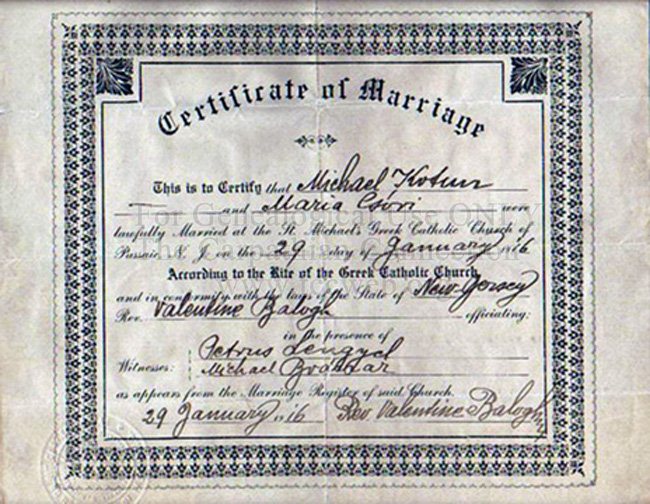
Early St. Michael's Baptisims
Maria Csanda
Born 15 of May 1908
Baptized 17 of November 1909 by Rev. I. Janiczky
Daughter of Michael and Maria (Joppa) Csanda
Godfather, Michael Hnatisin
Godmother, Annie Sirotnak
Courtesy of Steven M. Osifchin

John and Anna children of Vasil Haluska and Maria Petrusz. Both children died in infancy.
11 January 1911 baptized in the Greek Catholic faith St. Michael's Passaic, NJ. John born 10 January 1911. Parents Parents Vasil Haluska and Maria Petrusz. Godparents Vasil Hliba and Maria 'Grgyo'.Rev. I. Janiczky.
28 April 1912 baptized in the Greek Catholic faith St. Michael's Passaic, NJ. Anna born 21 April 1912. Parents Vasil Haluska and Maria Petrusz. Godparents John Bucsok and Maria Haluska. Rev. I. Janiczky.
Courtesy of Dennis Halusker
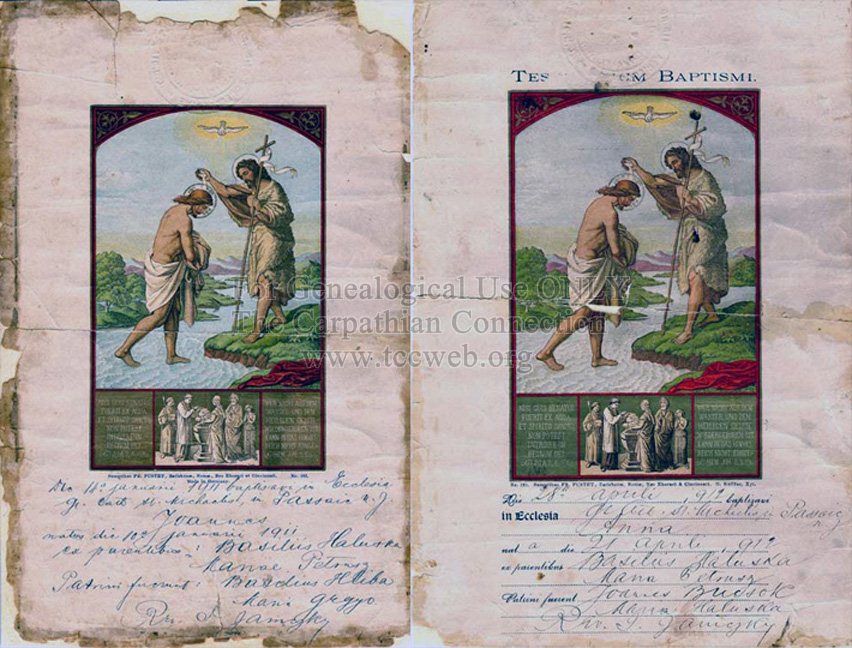
Please Visit the Gallery Section of our site to view the following:
St. Demetrius Lodge Photo 1916
TCC would like to thank Mrs. Avaline Sokol Nebesnak for offering us her original copy of this photo. The photo was taken Circa 1919. Several of those identified are men that left St. Mike's to start St. John the Baptist Russian Orthodox Church. Mrs. Nebesnak's Father, John Sokol, (Left 4th Row #3) was the only living charter member of St. John's before he passed away in 1982. (see headshot on the Gallery Page)
Additional Identifications
Nov. 2001 - My Father's maternal Uncle John Zavatsky, born in Hajtovka in 1862 is in Row No. 4, position No. 13. He resided on River Road in Garfield. Thanks to D.Crowley
Row No. 6, position No. 8 sure looks like my Father, Peter Dornics (aka Dornik) who was born in Ujak in 1896. I can't be sure but it looks like him. When I was born in 1939 the family went to St. John's RO Church. Thanks to John Dornik
I have been researching my Grandfather's family tree and he was a member of St. Michael's Church so one of the men pictured may be him. Thanks to Bill Vensko
Name the Performers in the Church Play
TCC would like to thank Linda Stufflebean for offering us a copy of this photo. The photo was taken in mid 30's to 1940's. Linda's grandmother Julia Scerbak Sabo is in the second row on the left. Julia's brother Peter Scerbak is directly behind her, with the hat on and the white banner across his chest.
Name the First Holy Communion Class of 1940
Thanks to Joy E. Kovalycsik for contributing her father Andrew Kovalycsik's Communion photo.
Early Members of the Parish 1900s
Parish Members 1920s
St. Michael's Choir 1919
Rusyn Choir 1920s
Parish Baseball Team
Church Play
Young Mens Association 1925
Trustees 1940
Church Council circa 1925
Altar Boys 1938
Holy Name Society Parade
Mothers Club mid 1900s
Mothers Club 1930s
Mothers Club 1940
Mothers Club and Altar Society 1960



